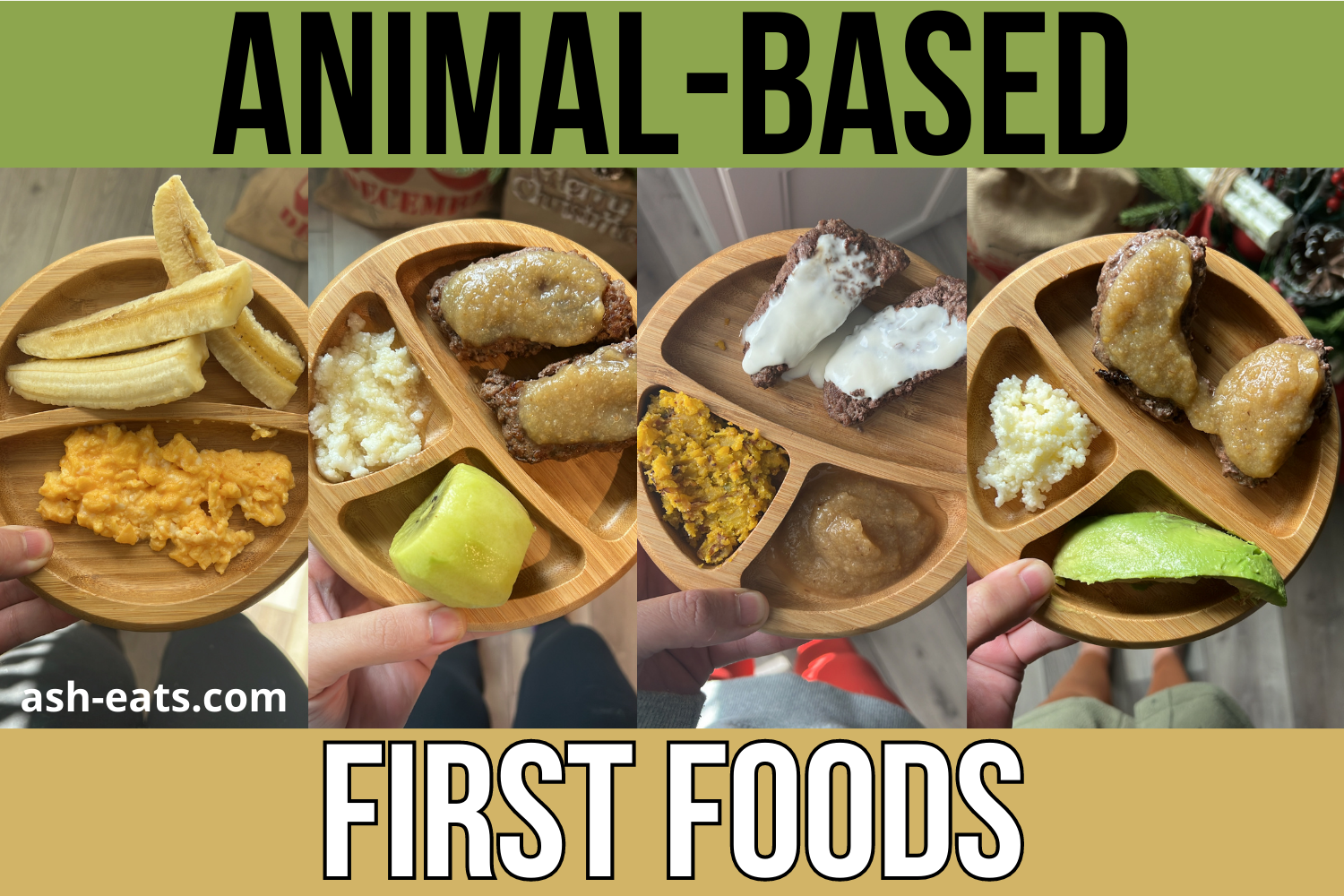
Published on January 12, 2023 by Ashley Rothstein
Hey there! You probably landed on this post because you follow an animal-based diet and want to feed your baby the same nutrient-dense foods you eat.
If this is you, you’re not alone. I receive messages from parents who eat animal-based diets and want to feed their babies in the same way, but aren’t sure how to do it as conventional advice points them in the opposite direction.
“Give cereal as a first food.” “Raw dairy is dangerous for babies/kids.” “Delay the introduction of meat.” “Veggies, veggies, veggies.”
My husband and I both do very well on an animal-based diet, and on top of that, my pregnancy (which was great) was fueled by animal foods. Same with my breast milk, which has always been plentiful.
So for me, I could not imagine giving my daughter anything but animal foods as her first foods.
In fact, creating well-rounded nutrient-dense animal-based meals for her has been one of the most fulfilling things I have ever done.

In this post, I:
- discuss my thoughts on baby-led weaning vs. standard weaning (purees),
- walk you through how I create animal-based meals for my daughter (she is 8 months old),
- provide 20+ sample meals and recipes,
- link the tools we use,
- go over eating frequency, cup/utensil practice, and more.
For more animal-based pregnancy, birth, postpartum, and motherhood resources, check out the pregnancy section on my website.
Heart & Soil Films featured our story in their mini-documentary, Nourished, which spotlights animal-based pregnancies. Click on the above image to watch it on YouTube.
Baby-led weaning vs. standard weaning
Before I did much research on solids, I planned to do baby-led weaning (BLW).
If you don’t know what BLW is, it’s a feeding philosophy where instead of spoon-feeding your baby pureed/mashed food (also called standard weaning), you give them correctly sized age-appropriate solids. For example, the below graphic shows how Solid Starts (a popular BLW website/app) recommends serving steak at different ages.

When Farrah was about 4.5-5 months old, she started to show interest in food. Her motor development was also rapid, so my gut told me it was time to introduce some extra calories.
I bought a book on BLW and dove in.
I learned that babies are given large pieces of food to start. The idea is that they become familiar with the food, suck the juices out for nutrients, and eventually, intuitively learn to feed themselves.
This introduced a dilemma…
A part of me wanted to take the gradual approach and help Farrah learn how to feed herself, but my main priority was getting food in her.
I opened up Nourishing Traditions of Baby & Child Care (a book I continually reference for all things pregnancy/postpartum/motherhood) to see what it had to say about baby-led weaning. I found this section:
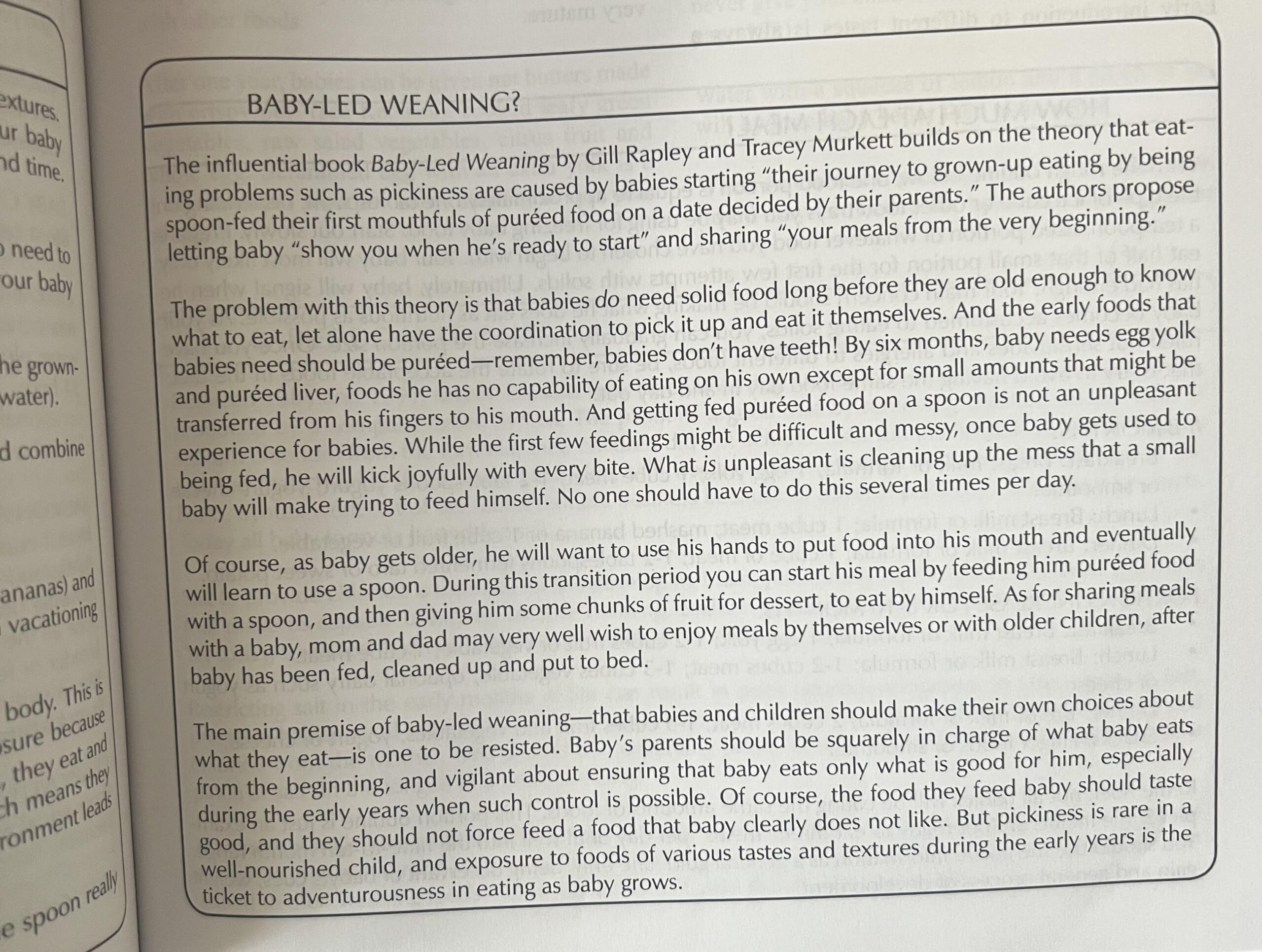
It mirrored exactly what my gut was telling me at the time*, so I decided to start with purees.
*Note: Farrah has practically inhaled nearly everything I’ve given her from day 1, so I don’t get the sense that she will ever be picky. While an alleged benefit of BLW is to prevent picky eating, my main reason for switching over was to encourage proper jaw/palate development and to nurture independence/learning by allowing her to feed herself.
Farrah’s first food was cod liver oil, followed by egg yolks, chicken liver, beef, bananas, raw butter, ghee, tallow, blueberries, raspberries, and apple/pear sauce – all pureed/mashed.
She happily gobbled everything up, but after a few weeks with the purees, I couldn’t shake an internal feeling that something wasn’t entirely right about it.
My gut wondered if pureeing 100% of her foods was some variation of coddling.
I shared my concerns with an online friend who also does BLW with her daughter.
She recommended the Solid Starts app. I followed them on Instagram (@solistarts) and watched a ton of their reels.
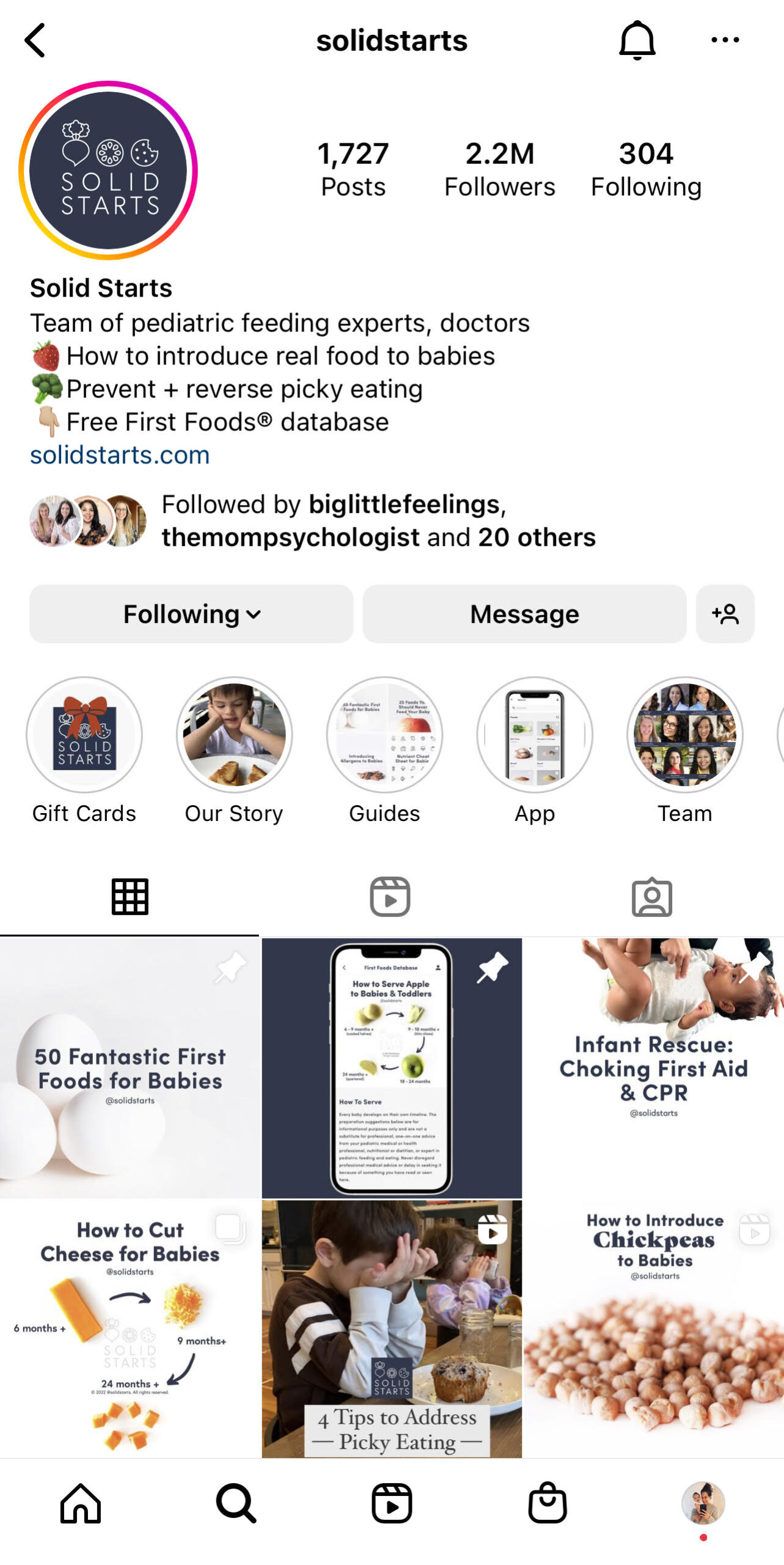
The more I saw and learned, my confidence grew and my fear decreased. I decided to make the leap and switch over to my own nutrient-dense animal-based mixed version of BLW. Farrah was about 6.5 months old at the time and I had been giving her purees for about a month.
I didn’t want to give up purees entirely. Perhaps it was the comfort and control they give me and/or a way to confirm she was actually getting food in her body. And who says you have to?
So I chose a mixed approach, which still works well for us to this day.
We do two meals per day: one BLW meal and one pureed meal. The BLW meal is fully formed and is usually her first meal of the day, and we do the puréed meal in the evening. I feed her the pureed meal but nurture her independence while doing so. I load the spoon and give it to her, and she grabs it and feeds herself.
And to clarify, BLW does include soft/pureed foods too. Things like yogurt, mashed potatoes, and apple sauce. The reason I call Farrah’s second meal of the day her “pureed meal” is because I mash foods I normally wouldn’t (like banana) to create a puree, whereas in traditional BLW, bananas are typically served formed.
I’m more tired in the evenings, so having to be less vigilant/focused with the pureed meal is nice. I may start to move away from doing this in the coming months, but it is a great way to get utensil practice in, so I may keep the pureed meal around for a while.
One criticism I’ve seen about a mixed BLW/puree approach is that it can confuse babies.
I’m not saying this isn’t true, but Farrah, so far at least, does not seem confused. She feeds herself when I put her plate down and eagerly opens her mouth and/or grabs the spoon herself when I have the bowl in hand to feed her.
She appears to understand exactly what we’re doing and adjusts herself appropriately, so I’m not sure if buy the “confusion” argument.

While I do not regret starting with purees, I’m grateful that I found the courage to try BLW and stick with it.
Farrah has experienced leaps in her development (and independence) since starting formed food, like gaining awareness of her mouth/jaw/hands/gag reflex and understanding how they’re all related. She would have never received this sort of learning during these formative months if I had given her purees only.
So, is BLW superior to standard weaning?
According to Lily Nichols, “baby-led weaning is linked to benefits, however many of these benefits are probably a reflection of the parents that naturally choose baby-led weaning.”
She expands on that in this article along with an in-depth discussion of introducing solids. It’s a great read if you want to learn more about BLW vs. standard weaning and feeding babies in general.
If you’re on the fence about BLW, I highly recommend giving it a try.
And if you’re scared of your baby choking, you’re not alone. More on this in the next section.
Setting expectations
For me, BLW has been a lesson in trust. The first few times were nerve-wracking.
I bought an anti-choking device and actually placed it right next to me the first few times I served formed meals.
There was lots of gagging – which I was not used to – and I was constantly on the edge of my seat waiting for something bad to happen.
If I look back in hindsight now and unpack my fear, I think it stemmed from 3 core things:
- conditioning
- those around me enforcing the conditioning
- not understanding the process
Conditioning
If you put a 6-month-old baby in front of an average person, give the baby a fully formed ground beef patty, and ask that person what they think, they’d probably tell you that the baby will choke.
Many people think this way because of what they’ve observed over the course of their life…through what their peers/family did and what they’ve seen in movies and online.
Even my husband told me, “I have never seen anything like this before,” as he watched our toothless daughter bite off a large chunk of skirt steak.
So when I served my daughter her first plate of ground beef patties and banana spears at 6.5 months old, I thought, “am I crazy for doing this? Am I going to kill my kid?”
But what resulted has been quite different…at least so far.
After watching Farrah eat formed food as young as 6.5 months and still, now, at 8 months, it’s like she knows exactly what to do with it…and has all along.
I’m in awe when I watch her take a huge bite of a banana spear, suck on the piece until it’s mashed, then swallow it like a champ.
Or take a bite of a ground beef patty (she did this when she had no teeth, I may add), suck on it until it becomes soft, attempt to swallow it, have her gag reflex correct her, bring it up with saliva to increase moisture, spit some of it out, then suck on the remaining bit until it is soft enough to successfully swallow. animal-based first foods solids

Some days, she’ll go right for the meat and chow down. On other days, she wants little to do with meat and devours the fat and carbs.
Her body is intelligent and does all of these things automatically.
Once I observed this process with my own eyes, it changed things.
I realized that while one of the reasons why I initially decided to go with purees was to give her extra calories, I was also fearful because of what I was conditioned to believe…that babies who do not have their food mashed/pureed will choke.
Making the food soft and easy for her made me feel better. It wasn’t necessarily the better (or the only) choice for her.
And in fearing (and therefore avoiding) what I didn’t know, I undermined her ability. And I would have never seen or experienced her ability unless I got out of my own way…and hers. animal-based first foods solids

Reinforcement of conditioning from those around you
The first day I served a formed meal to Farrah, I was a bit spooked.
She gagged a lot, and I wasn’t prepared for it.
My husband walked by while I was feeding her. I looked at him with a “deer in headlights” look, asking for help without actually asking for help.
He threw his hands up and said something along the lines of, “keep me out of it, I can’t deal with seeing her gag like that.”
After she was done, I sent the below photos to my parents and brother. It’s not every day you see a 6.5-month-old chowing down on a burger. animal-based first foods solids

I had some lingering stress in my body from the experience, so I called my parents to talk about it.
I’m not sure what I was expecting to hear from them since they’re a part of the pureed baby food camp, but I was met with hesitation and fear.
“Are you sure you should be giving her those big pieces?” “I just don’t see the point in doing this.” “We’re concerned and worried.”
The internal chaos I experienced during that conversation made me doubt if I was doing the right thing.
It can be hard to build enough confidence to go against what you’re conditioned to believe.
Even a smidge of resistance from your tribe can be enough to make you doubt yourself and propel you right back to what you know.
So when I was met with resistance, my knee-jerk reaction was to isolate and nurture the confidence I still had.
I decided to continue with BLW, but I didn’t involve anyone else for at least a week or two.
No photos, talking about Farrah’s mealtimes, or feeding her around anyone.
And after a couple of weeks of building my confidence solo, I felt great about my decision and cared much less about what anyone thought.
To this day, when my parents are over, they still are still uncomfortable (edge-of-the-seat antsy vibes) during Farrah’s mealtime. My mom even had to leave the room once after a gag that was challenging for her to see.
But I know that I’m doing the right thing for my daughter, which outshines any sort of outside influence.
It can be hard to get to that intrinsic place, especially if you find yourself surrounded by opposing opinions.
So if you find yourself around people who are doubting your choice to do BLW, I recommend operating alone (or around people who support your decision) until you build enough confidence to not care about what outsiders say. animal-based first foods solids

Not understanding the process
I’ve heard that people react to things they don’t understand.
This was true for me when I started serving formed food.
I would get really anxious around Farrah’s mealtime. While she ate, I sat with the anti-choking device next to me…on the edge of my seat.
“Is this a gag or a choke?” “Do I do something now?” “Where is the inhale?” “She is red, that can’t be good.” “Why the hell am I doing this?” “This is taking a bit too long, I should intervene.”
All of these thoughts came racing in at warp speed with each gag. And if she wasn’t gagging, I was anticipating the next gag.
The anxiety was strong the first few days but rapidly decreased as I began to trust her.
As I mentioned before, seeing the process with my own two eyes changed everything.
Watching her feed herself over the course of days/weeks/months helped me understand what was going on and progressively trust that she knew what to do. This is something you can’t get from a book or a blog post or even someone telling you about their positive experience. You need to see it and experience it with your own child. animal-based first foods solids
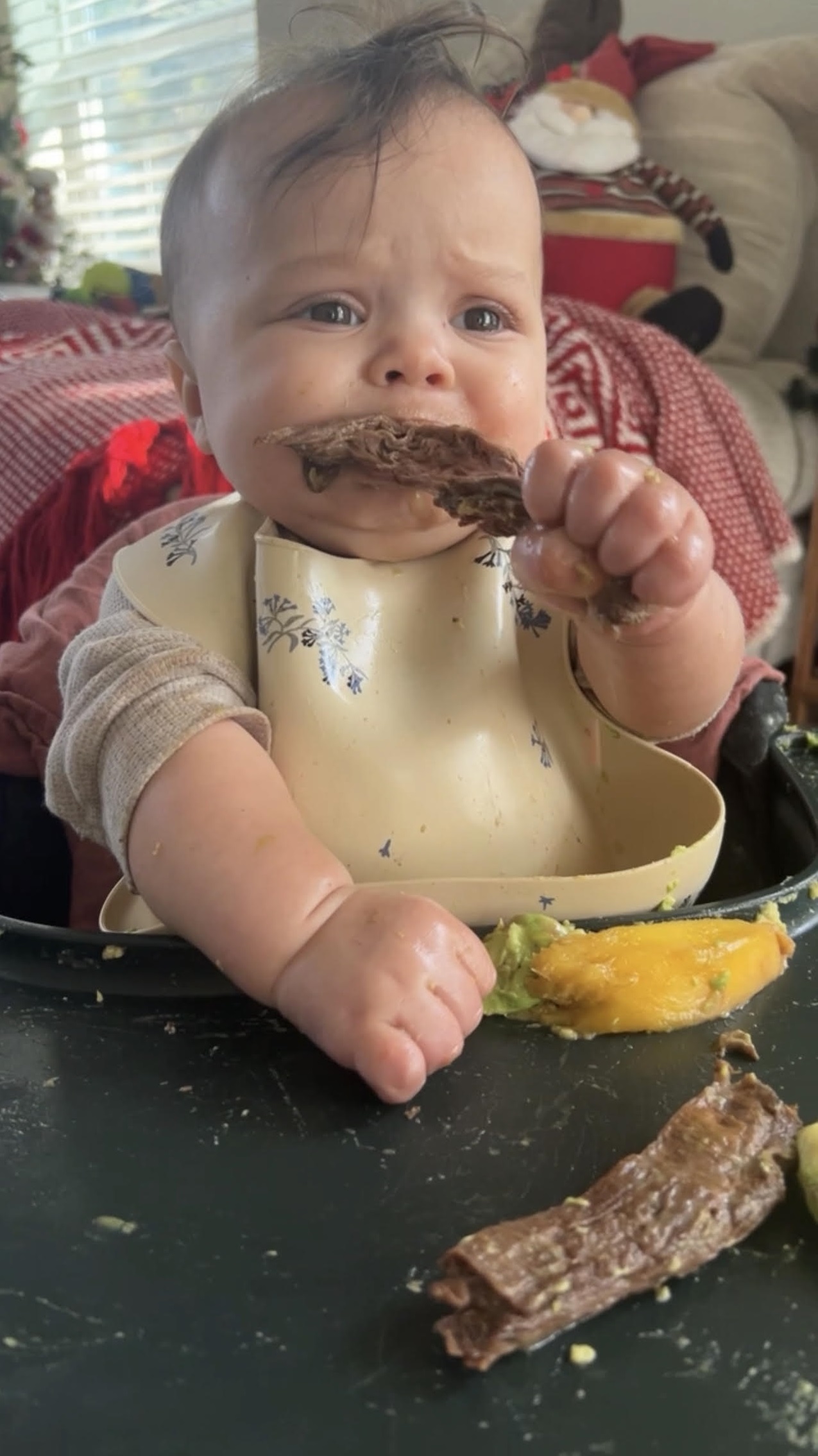
Something else I underestimated was how fast Farrah would learn to eat and how much food would actually go down.
Now at just under 8 months, she eats almost her entire meal. And I serve her pretty large meals.
She’ll put down the carbs and fat at the beginning of her meal, then nibble on her meat, getting down about half of what I serve (if not more) some days. And I usually serve her about 1/4 lb of meat in one sitting!
One of the reasons I convinced myself to start with purees was to make sure she was getting nutrients.
After just a month or so of BLW, she’s chowing down bananas spears and burgers (and many other things).
I quickly learned purees are not the only way to get nutrients in a baby. animal-based first foods solids
How to create an animal-based meal for your baby
If you don’t have the book Nourishing Traditions Book of Baby & Child Care, I highly recommend getting it.
As for what foods to feed Farrah and when, I rely mainly on this book. Below are some excerpts:
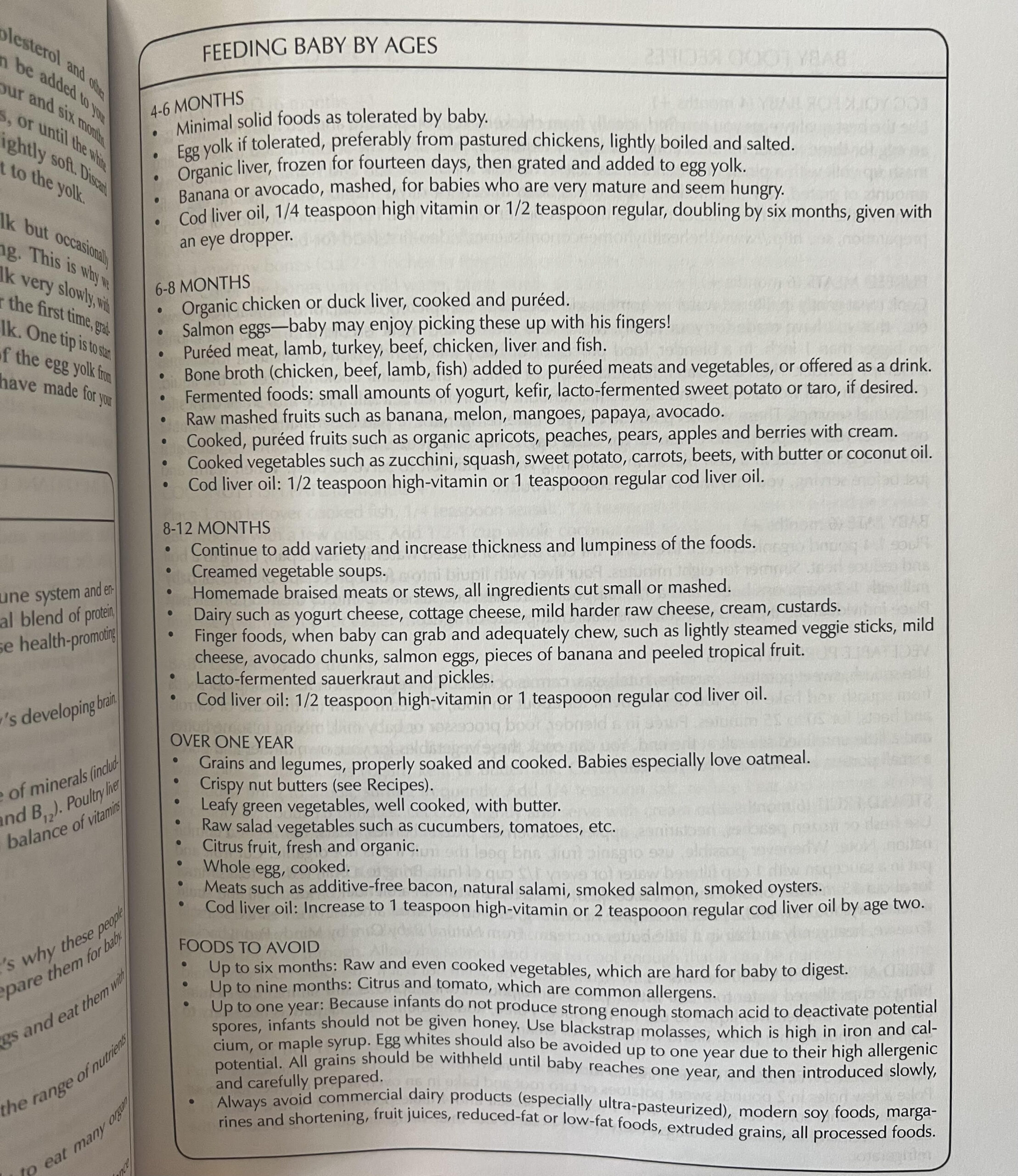
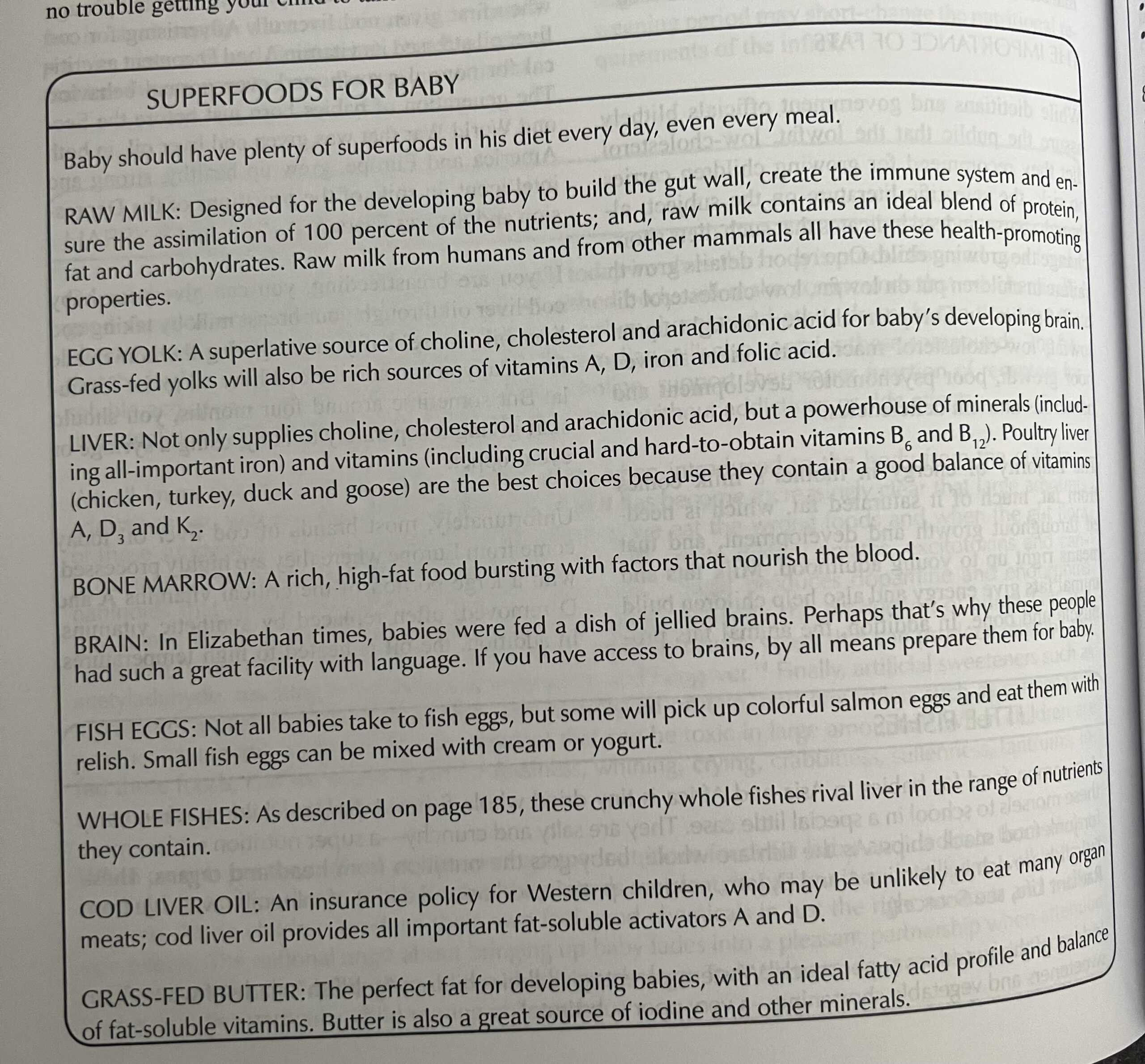
And as for how to cut and serve the food, I use the Solid Starts app. This post is helpful to make sure you’re serving the food in the correct size and shape. animal-based first foods solids
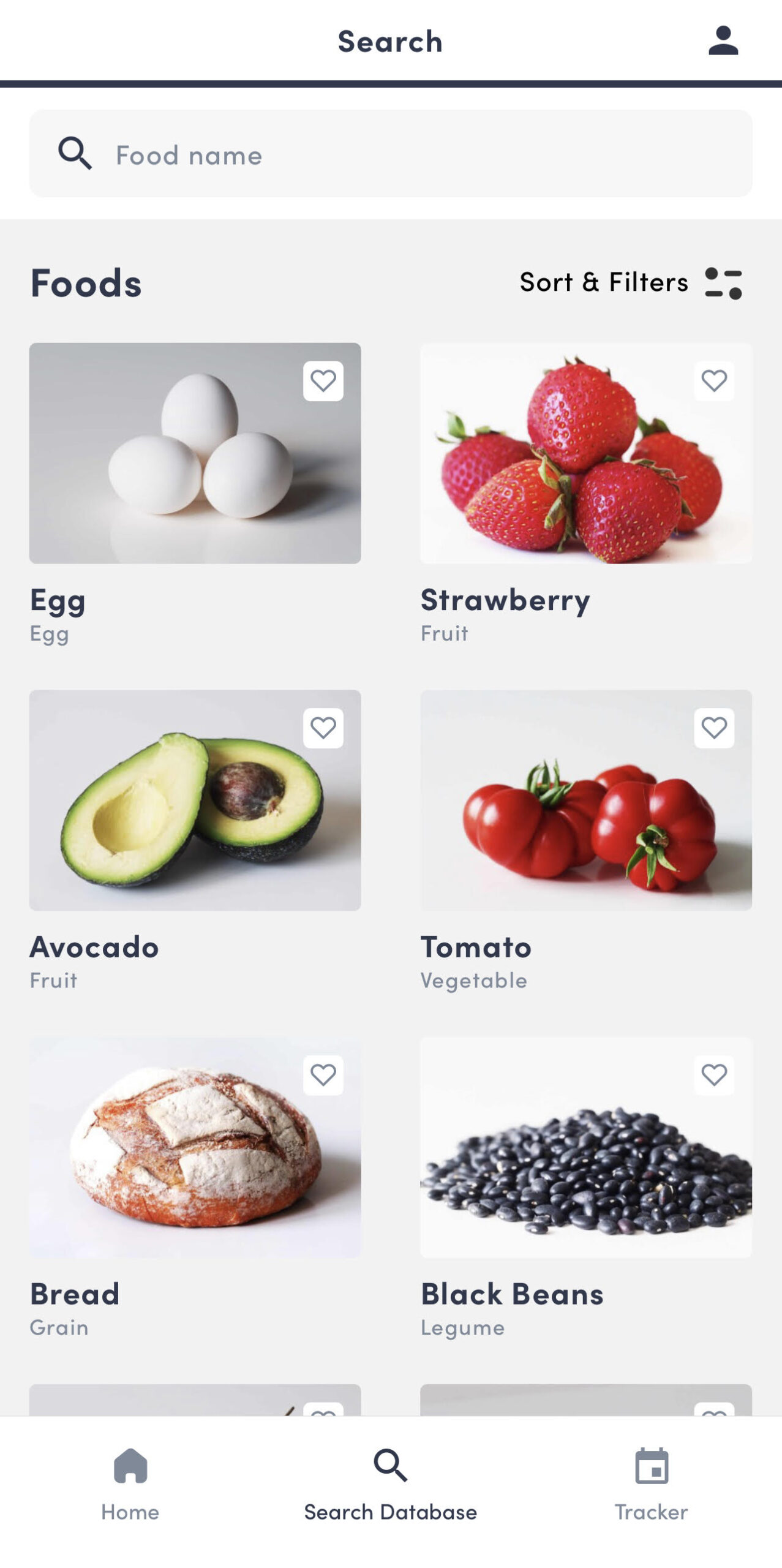
I usually serve protein, fat, and carbs with each morning meal. This may look like a piece of steak, ghee, and kabocha squash. Or venison, beef tallow, and banana spears.
For her evening meal, it’s usually fat and carbs. Like an egg yolk, banana, and ghee. Or raw cream and apple/pear sauce.
The meals I feed her look pretty similar day after day, but occasionally I’ll do something different/fun (like spaghetti squash pesto “pasta”). Or a new protein source, like venison or bison. It’s a treat for me too as I usually serve her a variation of what I’m eating, or something close.
Ground meat patties are the main way I serve Farrah meat. When I make them, I cook them low and slow so they have little to no char. My goal is for the meat to be as tender/soft as possible and fall apart in her mouth, making the patty easier for her to work through and less of a choking risk.
My goal is to expose her to as many whole foods as possible. Since I don’t give myself much variety these days, I also give her foods I don’t normally eat, like sauerkraut, raspberries, and potatoes.
According to Lily Nichols, research shows there is a critical flavor window between 5-7 months and a critical point for complex texture introduction at 10-11 months+.
So when it comes to choosing foods, I focus on four things:
- correctly sized and age-appropriate
- nutrient density
- balanced meals (protein + fat + carbs)
- exposure to varying textures and flavors
Below is an excerpt from Nourishing Traditions about how formative the food choices you make for your baby can be:
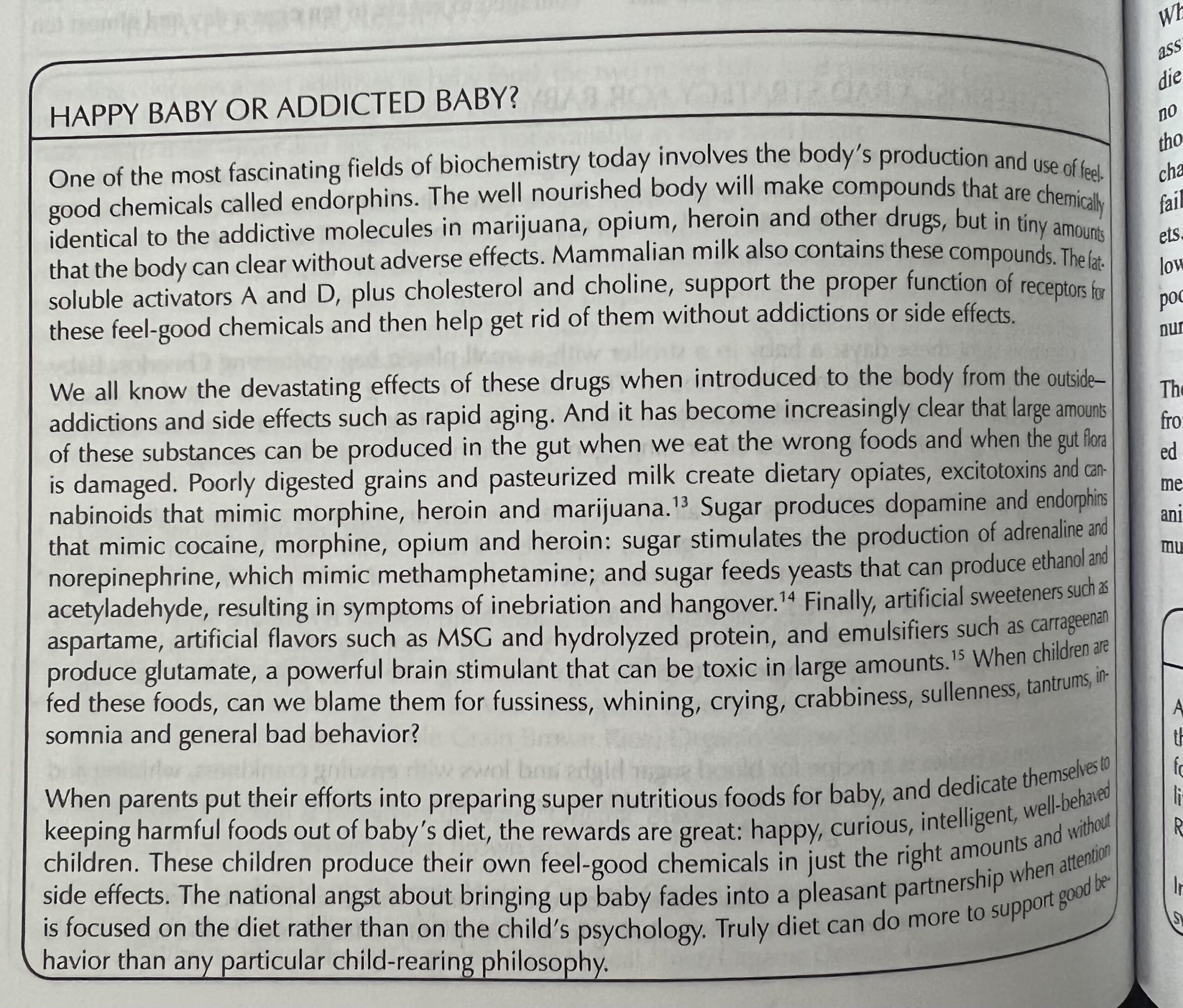
As for portions, I’ve always served Farrah large portions as I assumed it would be a while before she got most of it down. She now eats most of her food, so the joke is on me. However, I don’t think she would eat more than she needs, so I’ve continued to roll with the large portions and it seems to be working fine.
Nourishing Traditions has portion suggestions, but they’re geared more toward purees. animal-based first foods solids
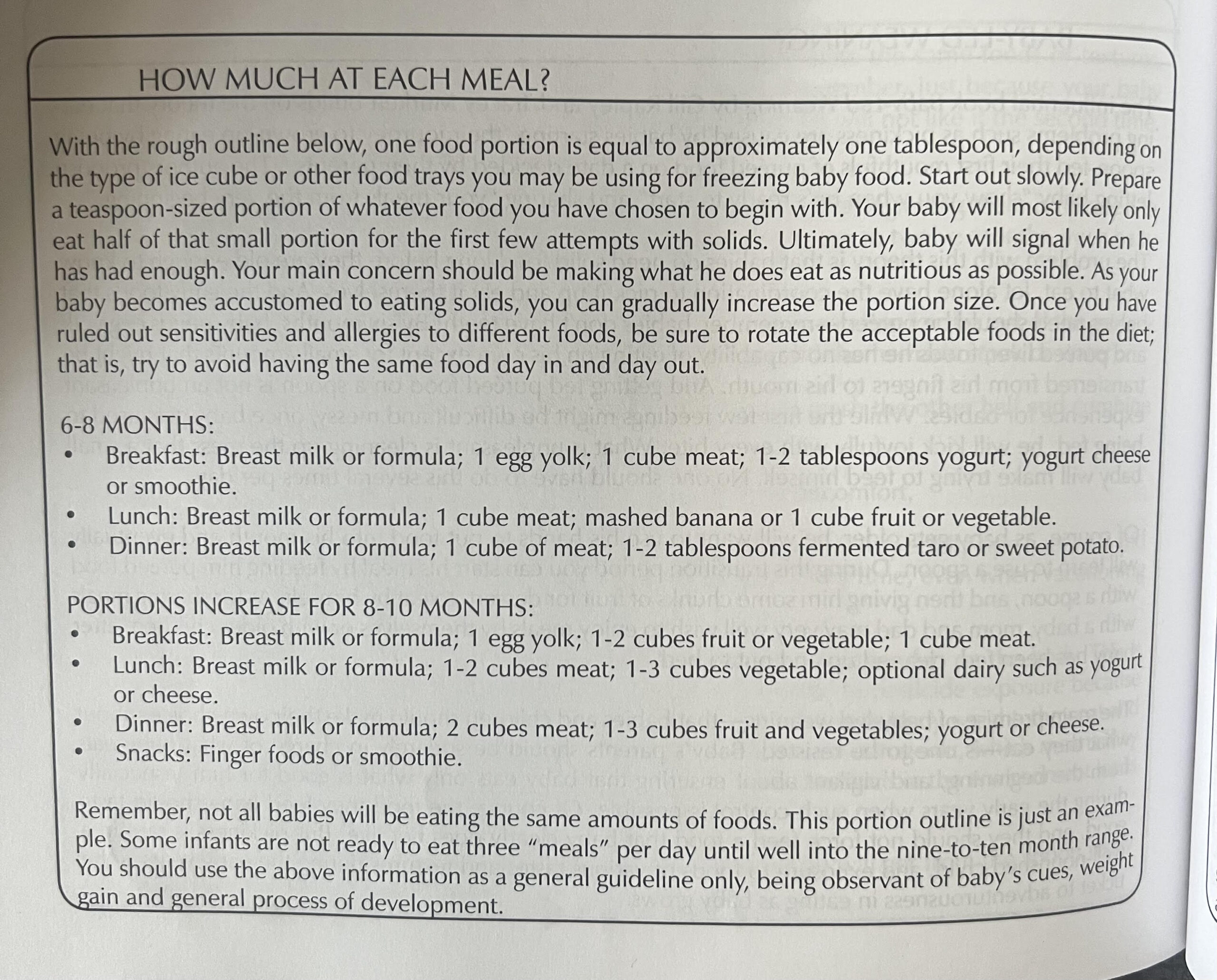
The number one question I get asked about Farrah’s meals (and mine) is how I “get the yolks like that.” For information about how I make our egg yolks, check out my “Egg yolks” highlight on Instagram. If you do not have access to Instagram, let me know.
As for salting food, I’ve heard both sides of the coin…”don’t salt baby food at all” and “babies need salt.”
When it comes to baby food, I think salt is over-demonized. Lily Nichols has a great article on this.
Below is an excerpt on salt for babies from Nourishing Traditions:
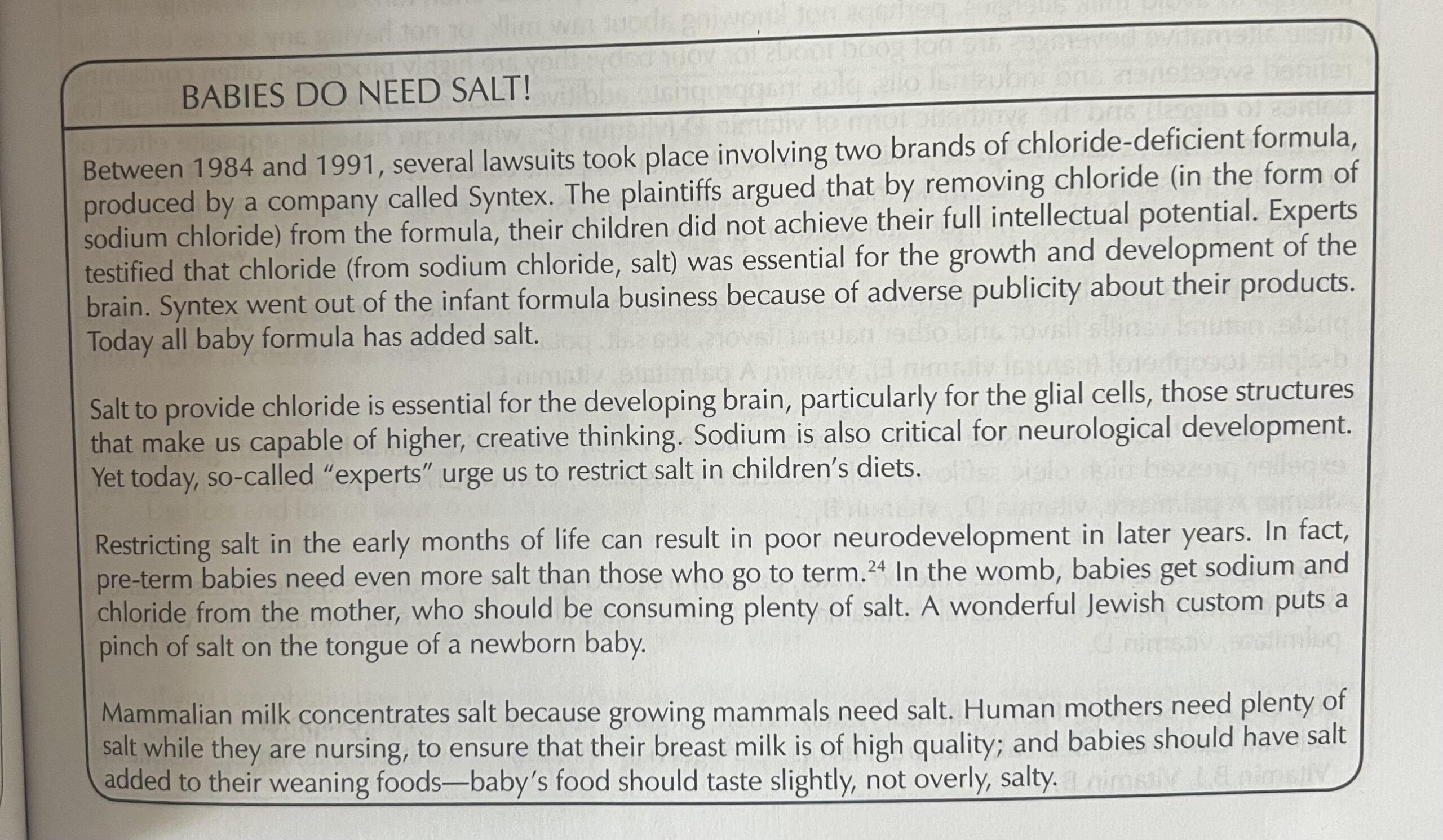
I lightly salt Farrah’s meat with sea salt and I also add sea salt to things like guac or sometimes do a light sprinkle on potato or squash spears (think fries). I leave everything else as-is for now. I’ll probably gradually salt her food more and more, especially as she weans and drops feeds in the coming year or two.
Here are some examples of the meals I give Farrah. animal-based first foods solids
First meal (formed):

Skirt steak + banana + beef tallow
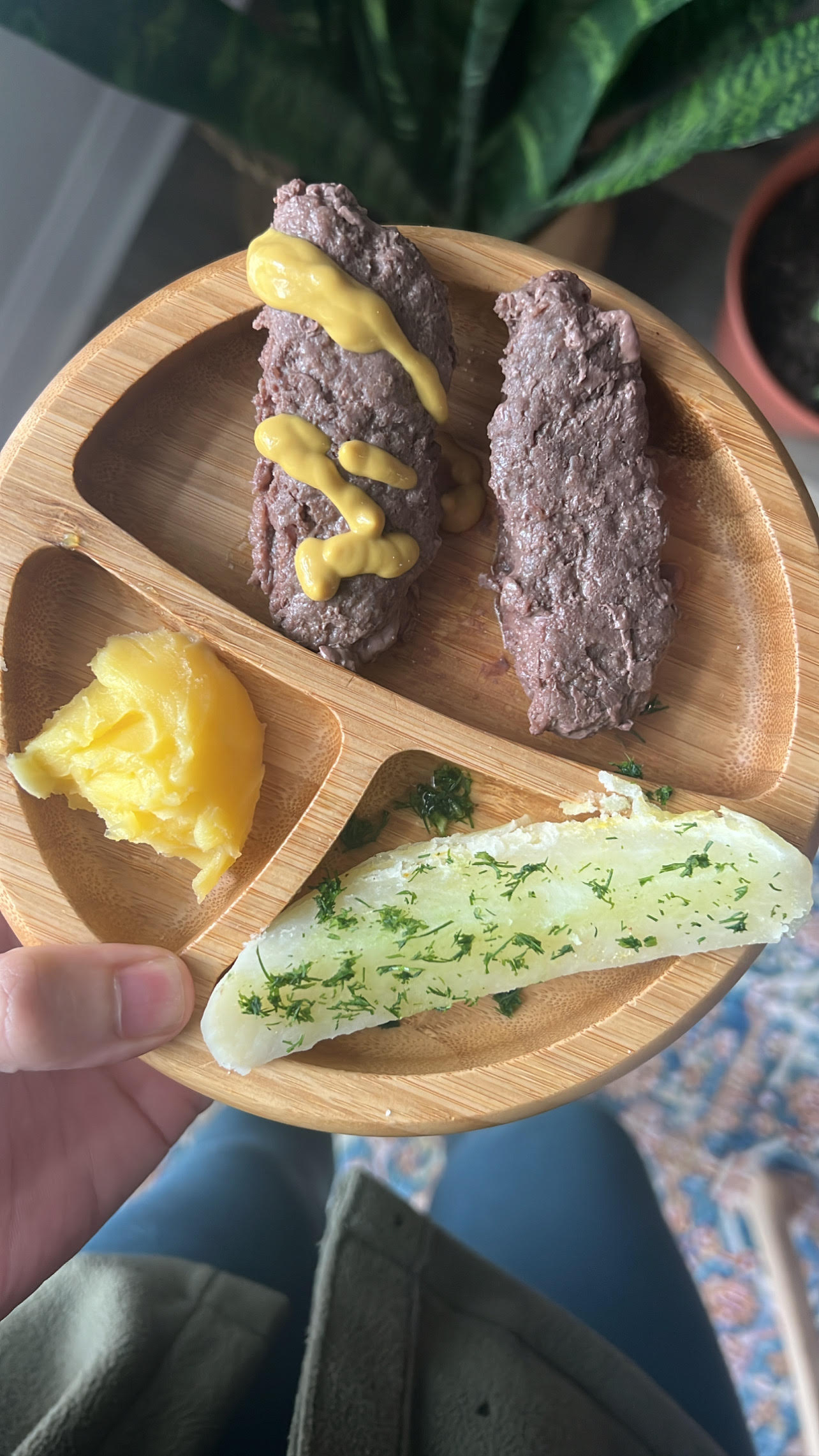
Venison burgers with mustard + potato spear with chopped fresh dill + ghee

Venison burgers with apple/pear sauce + ghee + mashed kabocha squash with ghee, smashed sauteed onions, chopped fresh dill, a little sea salt

Salmon, ghee, lemon, sea salt + acorn squash mash (acorn squash, lemon, ghee, chopped fresh dill, sea salt, splash of raw milk) + kiwi
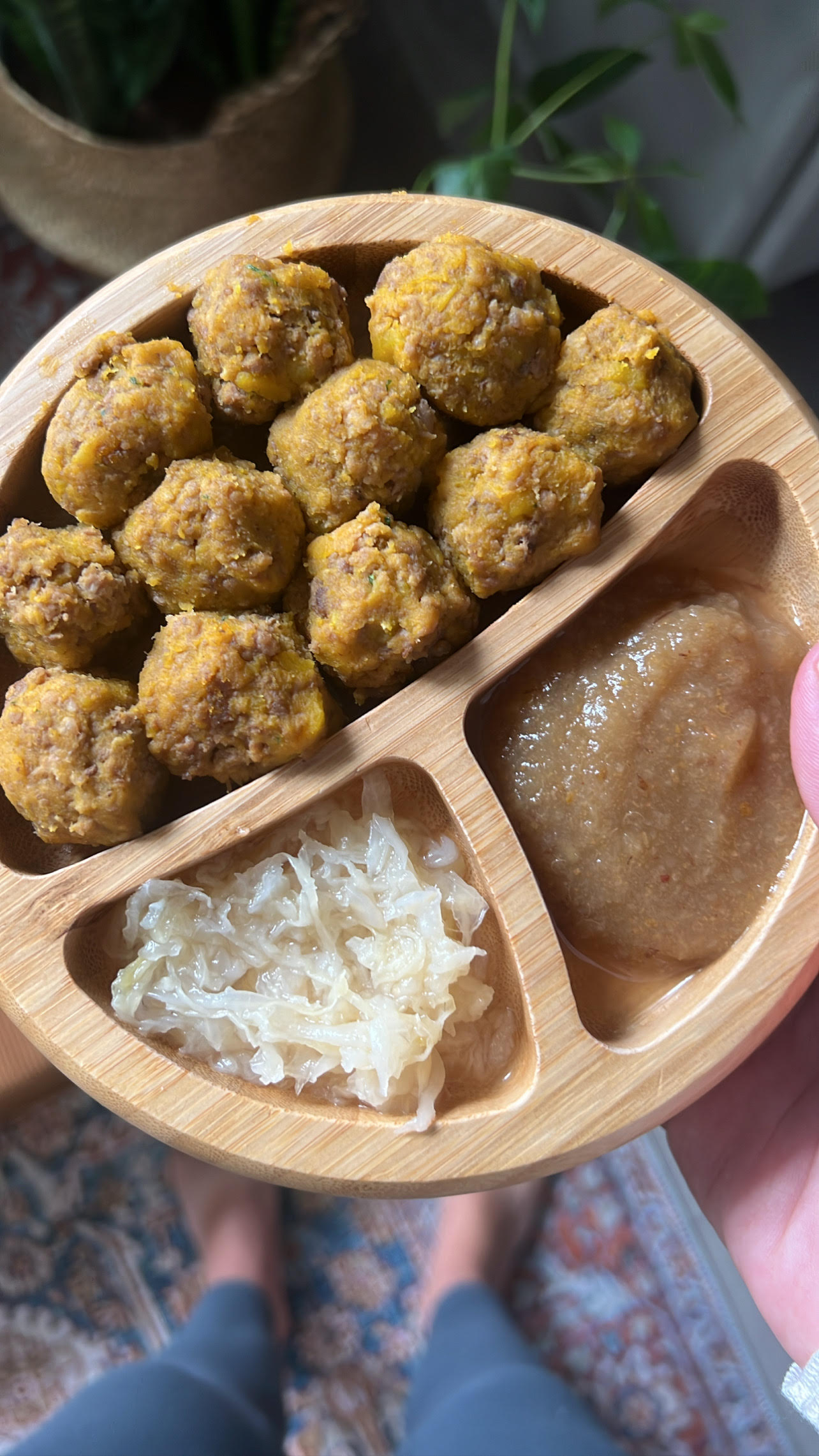
Ground beef, kabocha squash, ghee, sea salt meatballs + sauerkraut + apple/pear sauce

Liver + egg + banana + ghee + sea salt pancakes topped with chopped banana, whipped raw cream, and melted ghee

Modified “Loaded Burger Bowl” (recipe from my blog): ground beef + avocado + boiled kabocha squash + iceberg lettuce + small amount of raw cheese for flavor + tomato-free thousand island

How I served the “Loaded Burger Bowl”

Ground beef burgers with apple/pear sauce + mango mash with a splash of raw milk + beef tallow
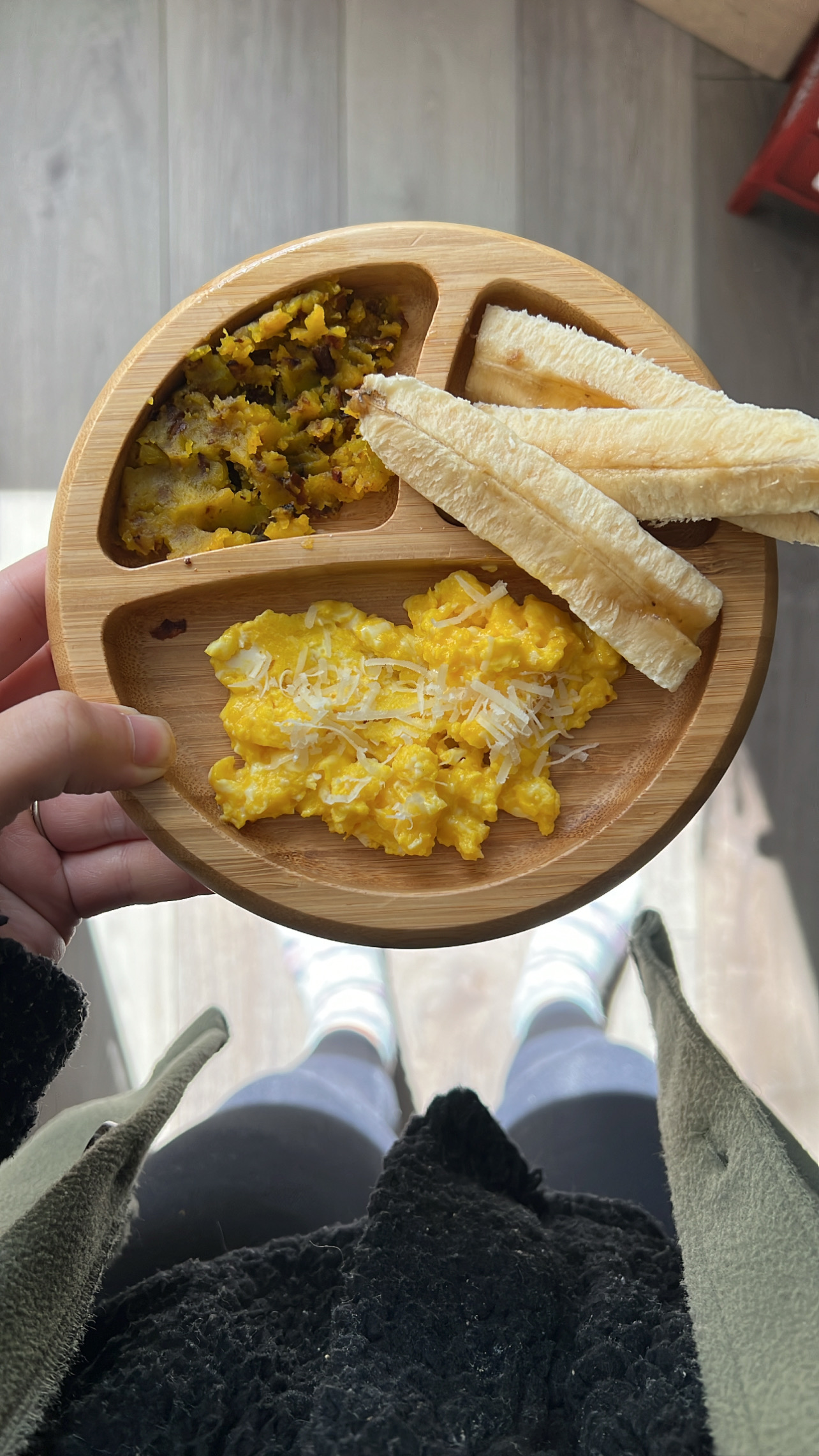
Soft-scrambled eggs with a little Parmesan + mashed kabocha squash + banana
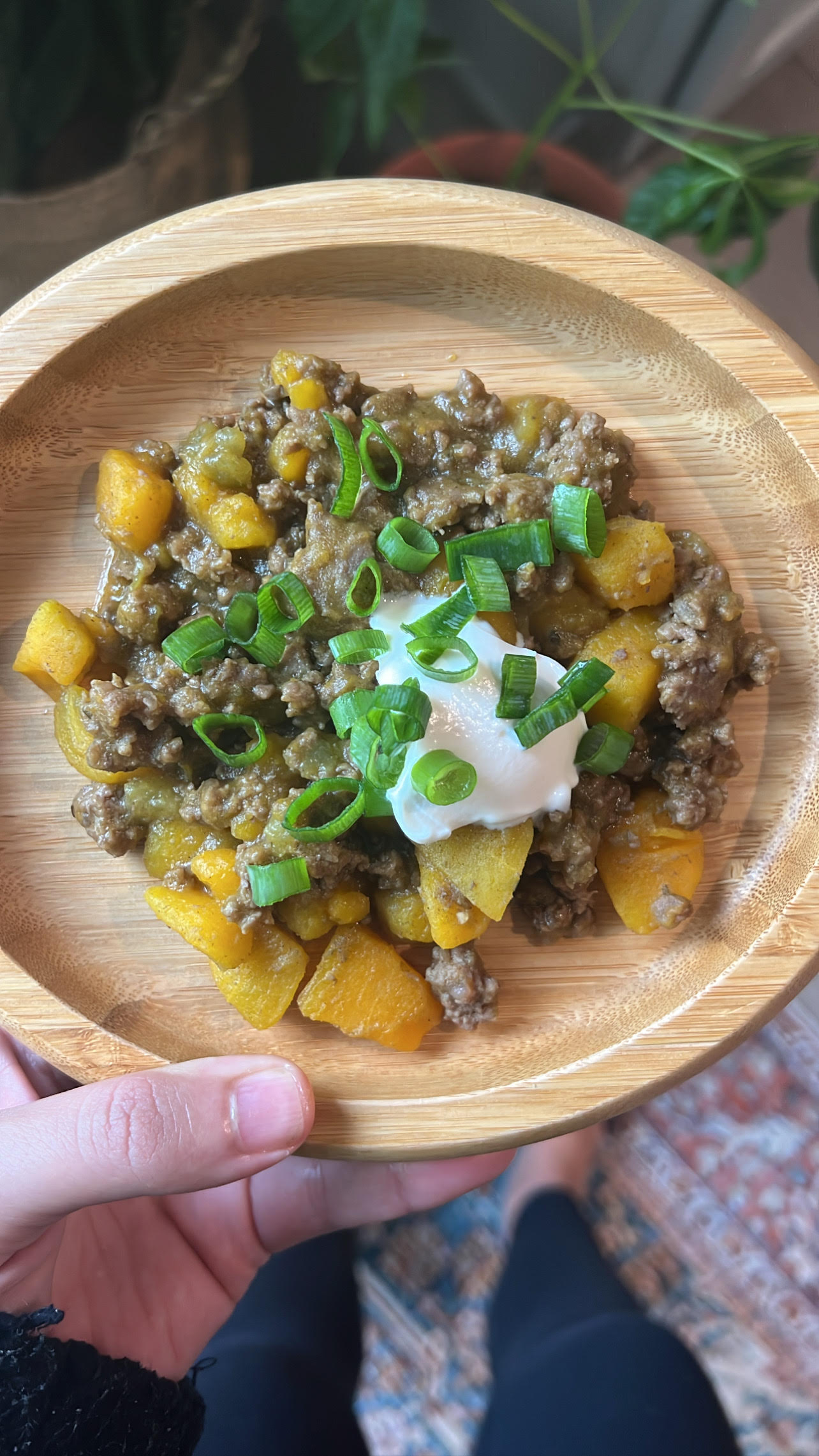
“Nightshade-free Chili” (recipe from my blog) topped with raw sour cream + chopped green onions
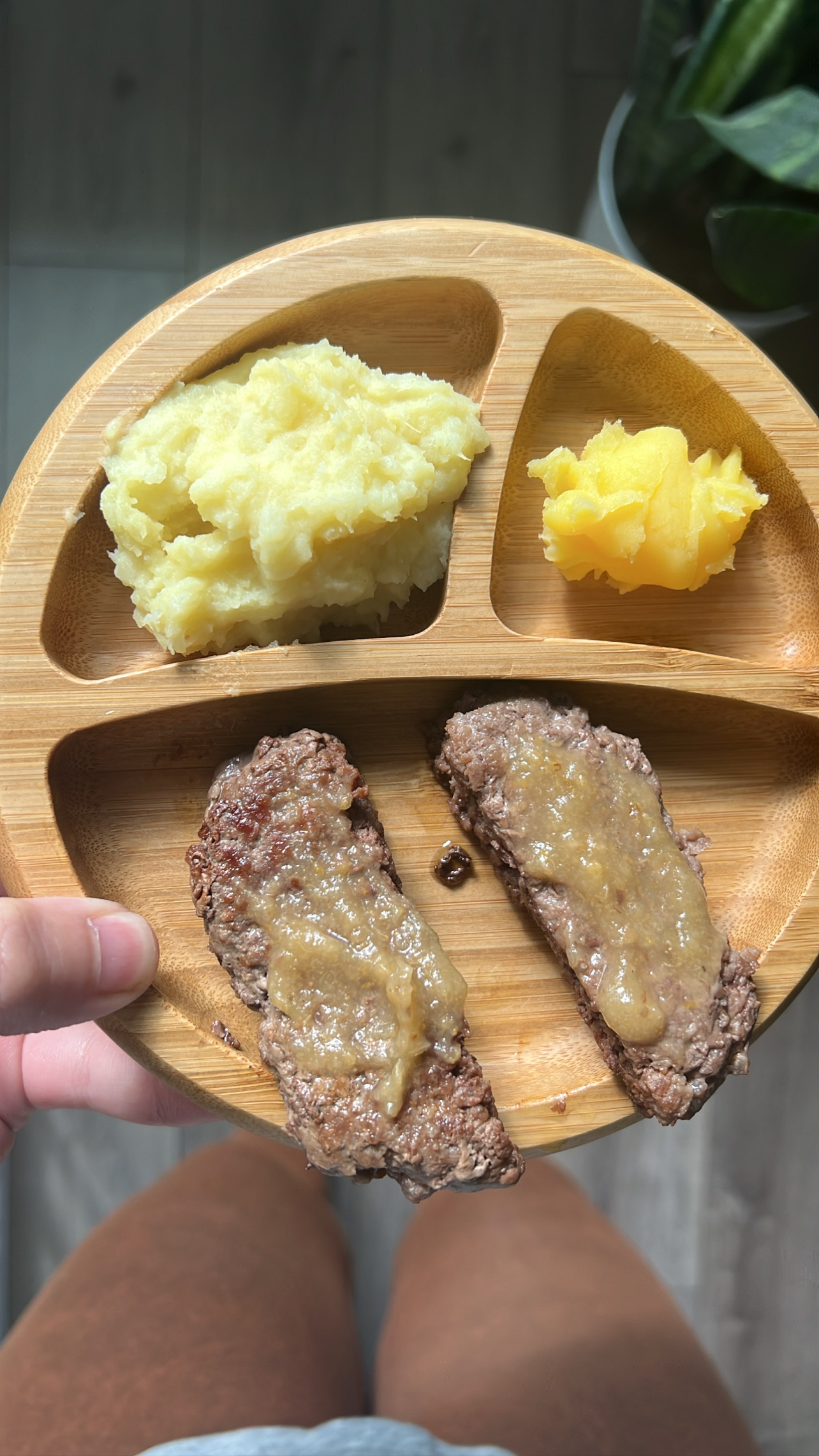
Ground beef burgers with apple/pear sauce + mashed sweet potato with a splash of raw milk, ghee, and a little sea salt + more ghee

Ground beef burgers with apple/pear sauce + kiwi + beef tallow
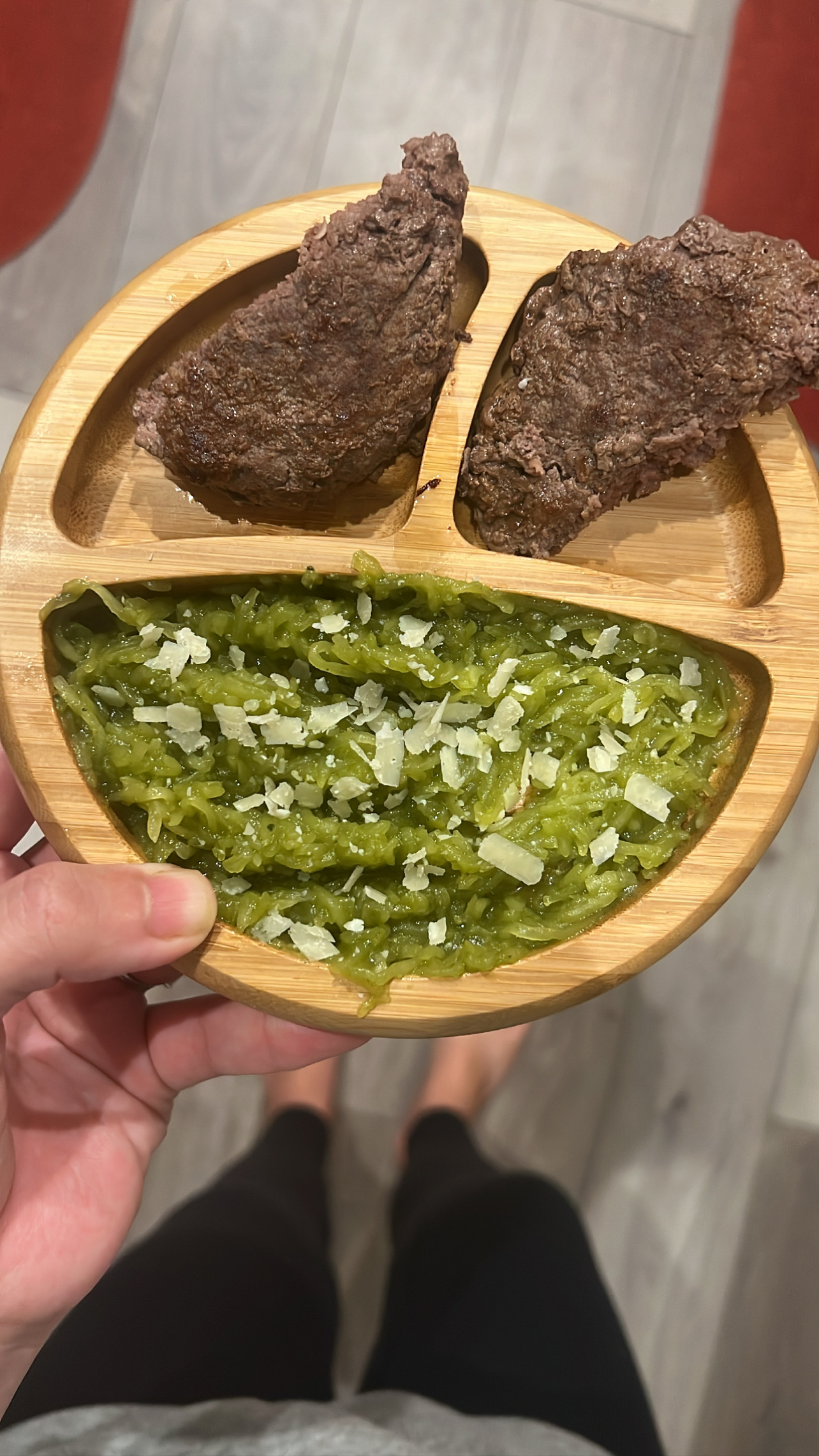
Ground beef burgers + spaghettis squash “noodles” with pesto sauce and a little Parmesan cheese
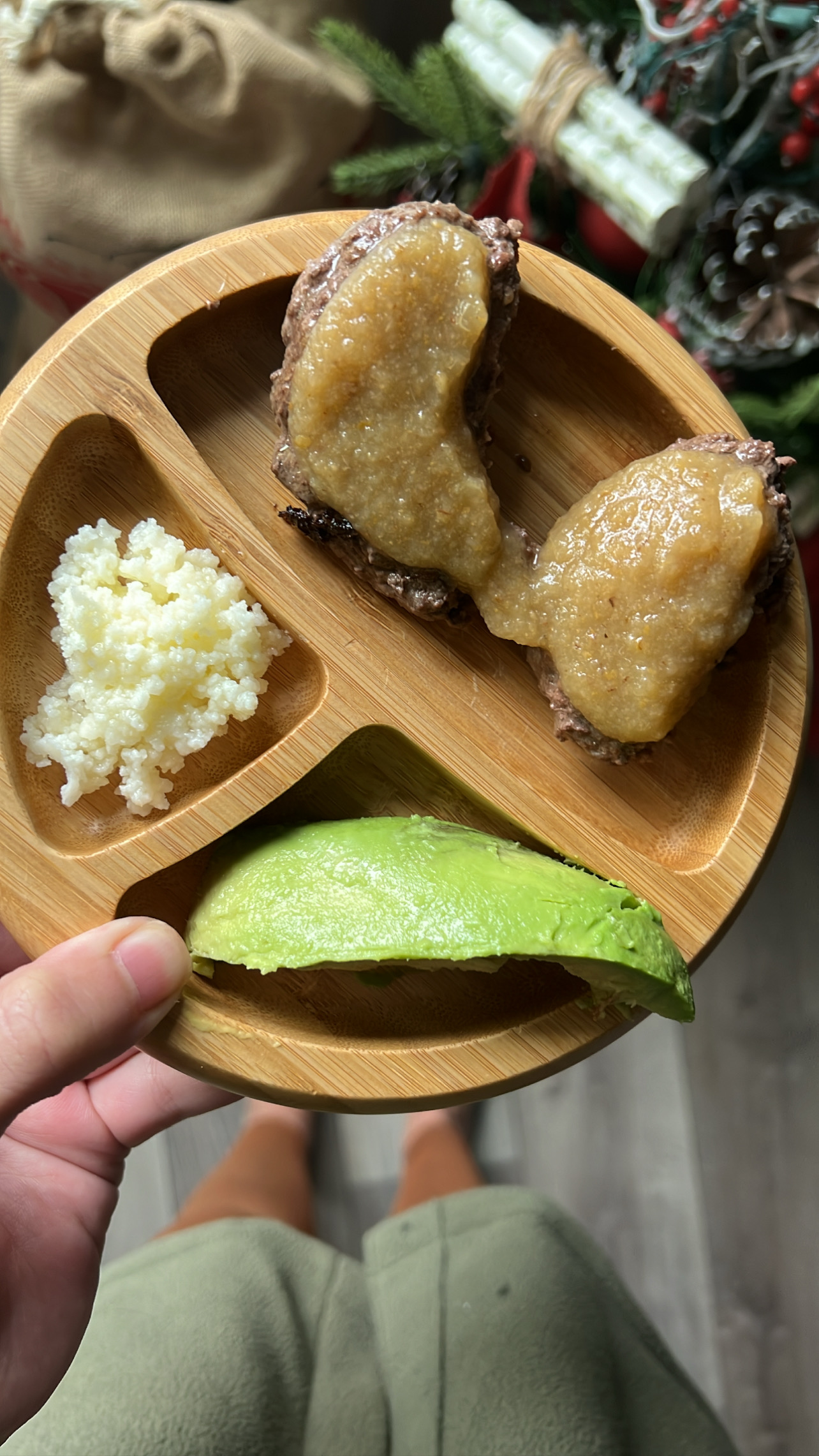
Ground beef burgers with apple/pear sauce + avocado + beef tallow
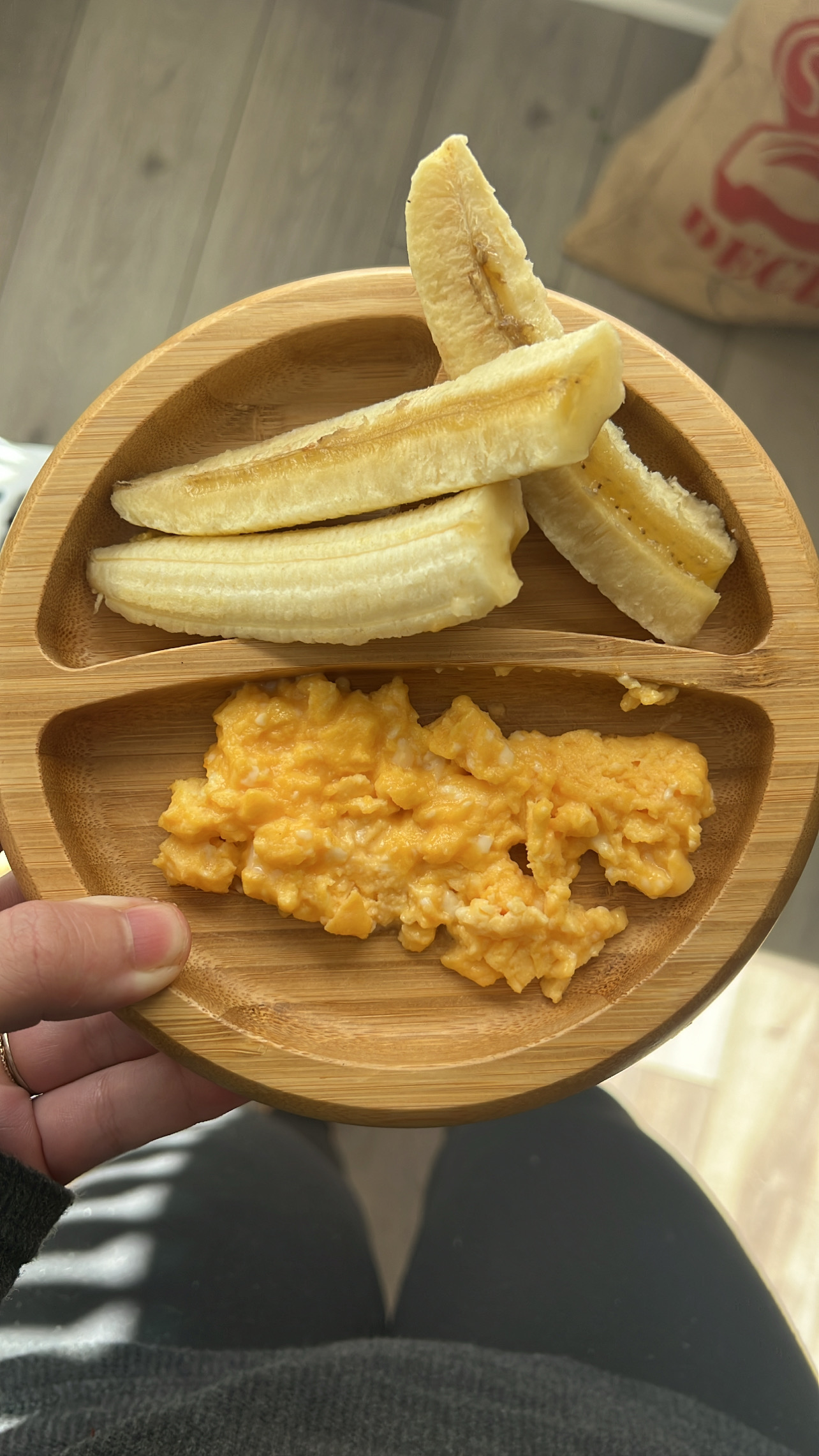
Soft-scrambled eggs + banana

Skirt steak + banana + ghee

Skirt steak + melt-in-your-mouth kabocha squash “fingers” + ghee
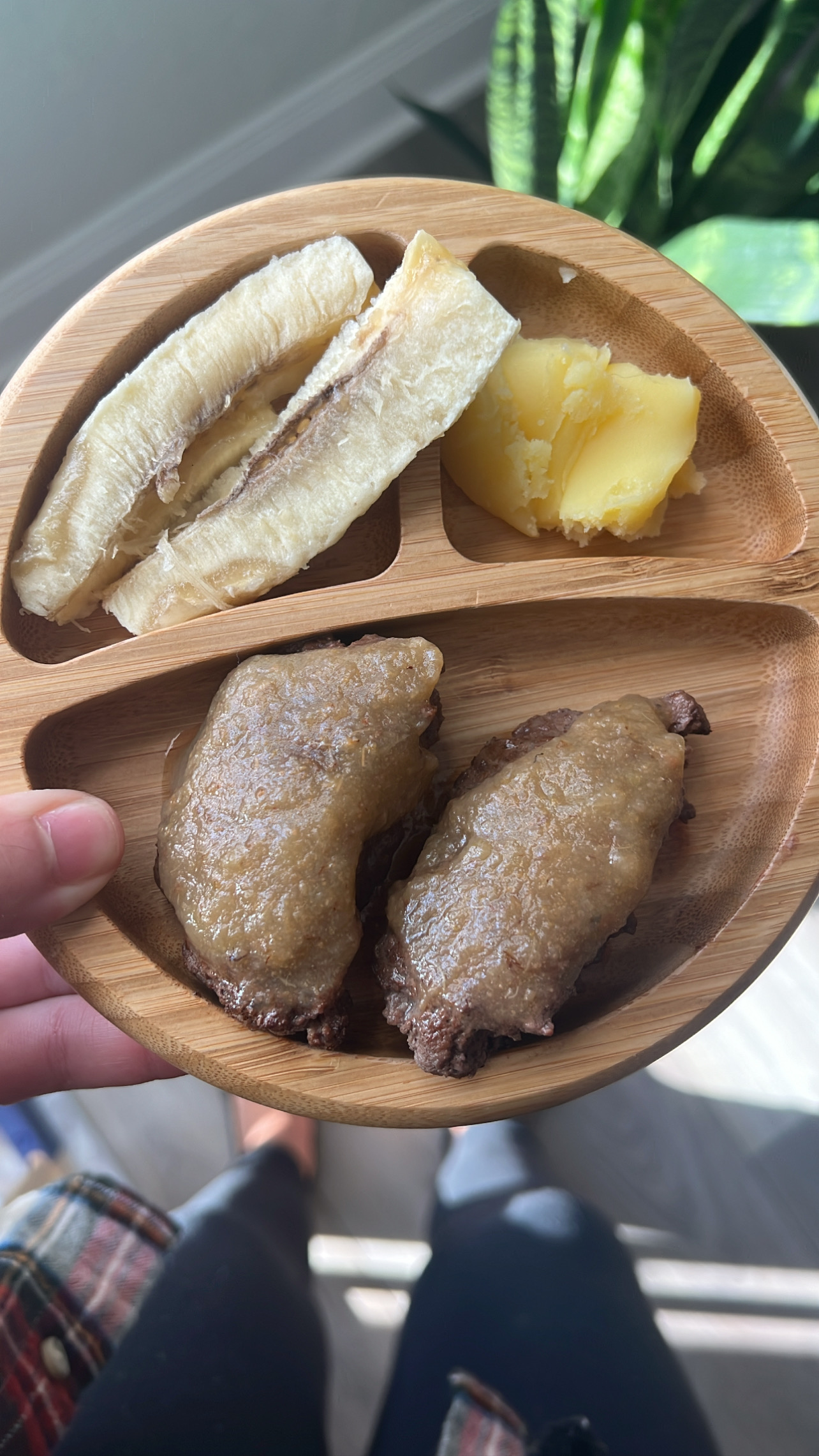
Venison burgers with apple/pear sauce + banana + ghee
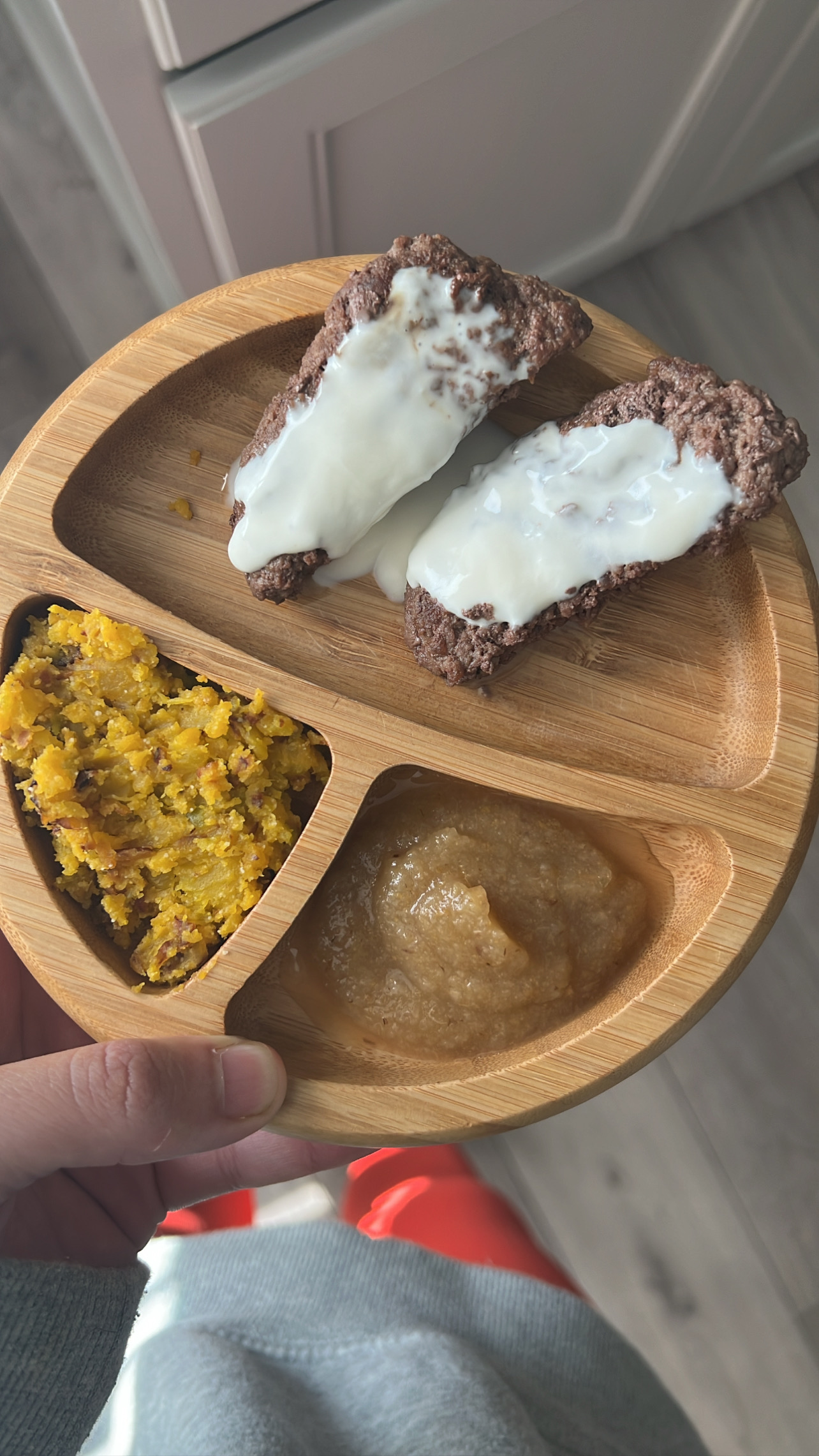
Ground beef burgers with raw sour cream + mashed kabocha squash + apple/pear sauce
Evening meal (pureed):

Guac (avocado, lemon, lime, cilantro, sea salt) + kabocha squash + raw sour cream + egg yolk

Egg yolk + guac (avocado, lime, lemon, cilantro, little bit of sea salt)
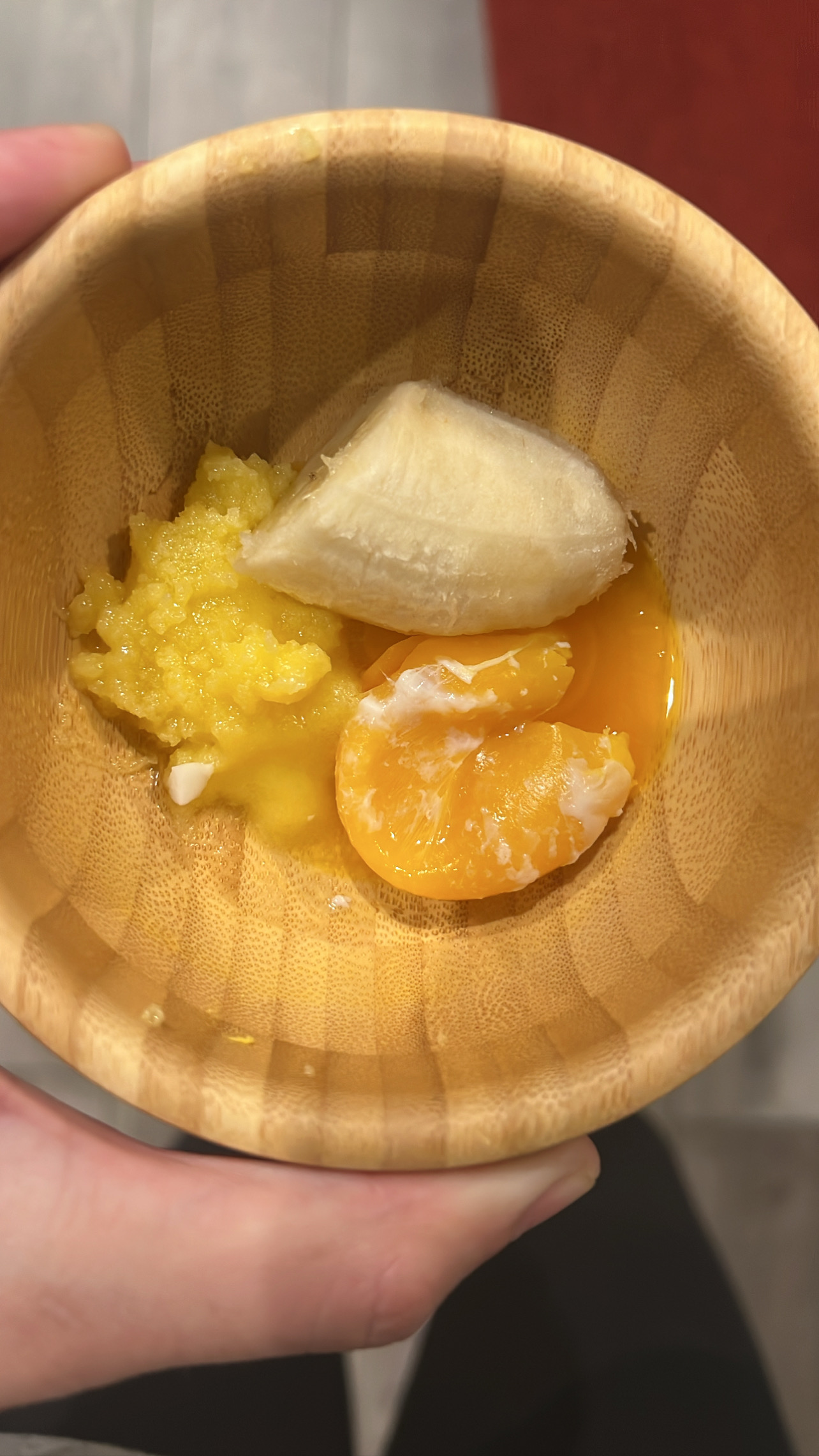
Banana + ghee + egg yolk

Chicken liver + banana
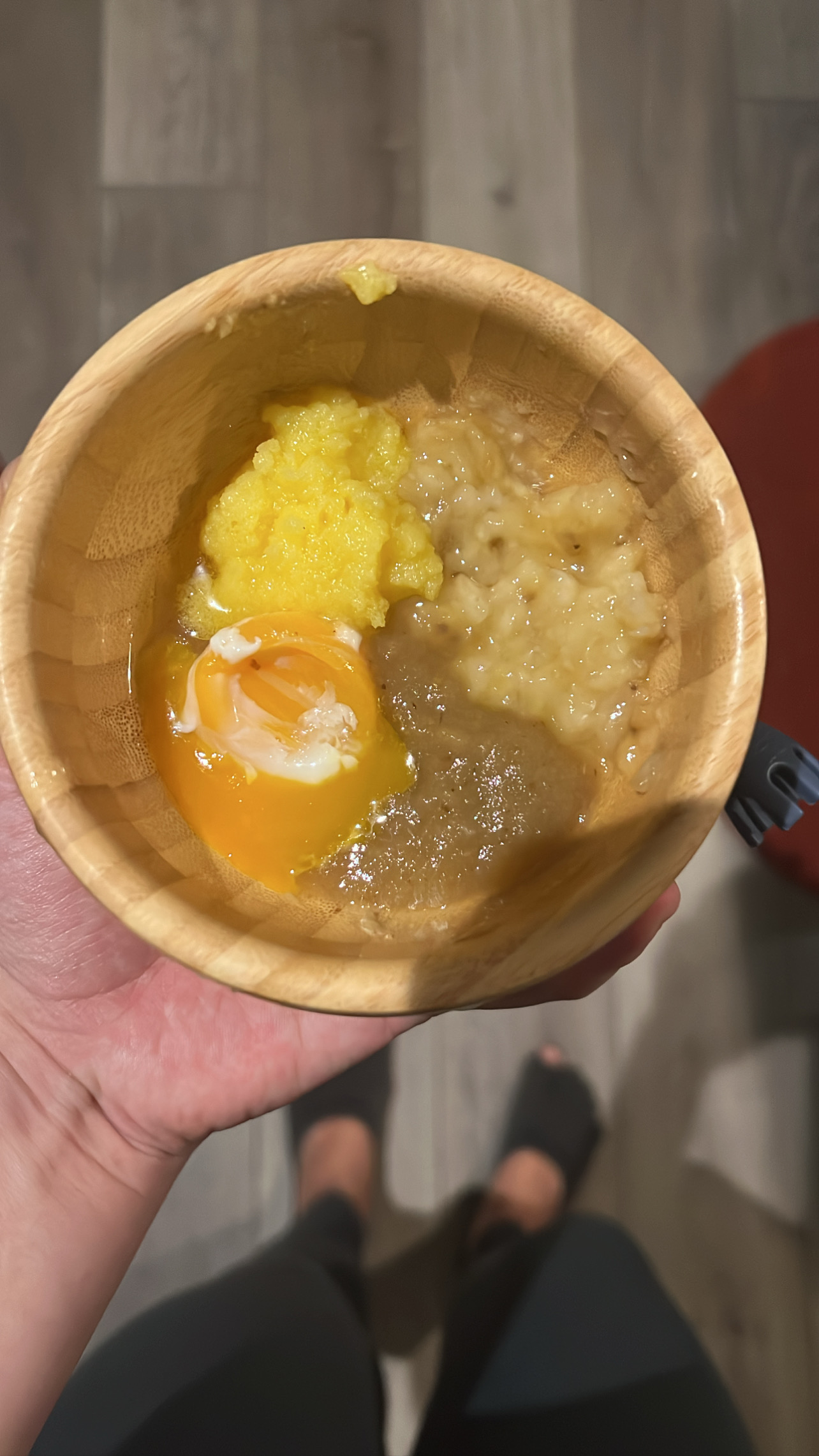
Egg yolk + ghee + banana + apple/pear sauce

Egg yolk + kabocha squash mash + banana + Heart & Soil Bone Marrow & Liver capsule
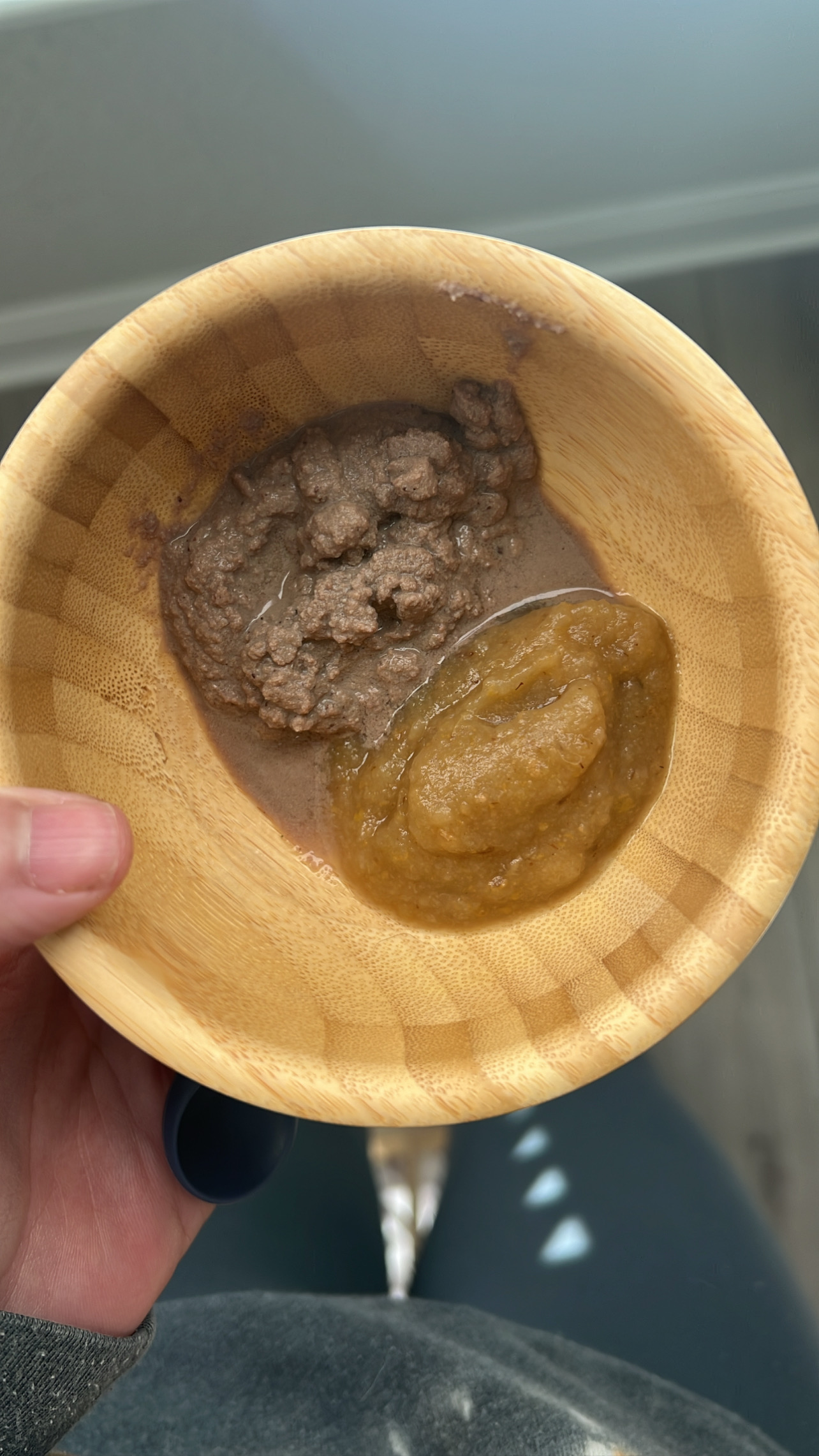
Chicken liver + apple/pear sauce
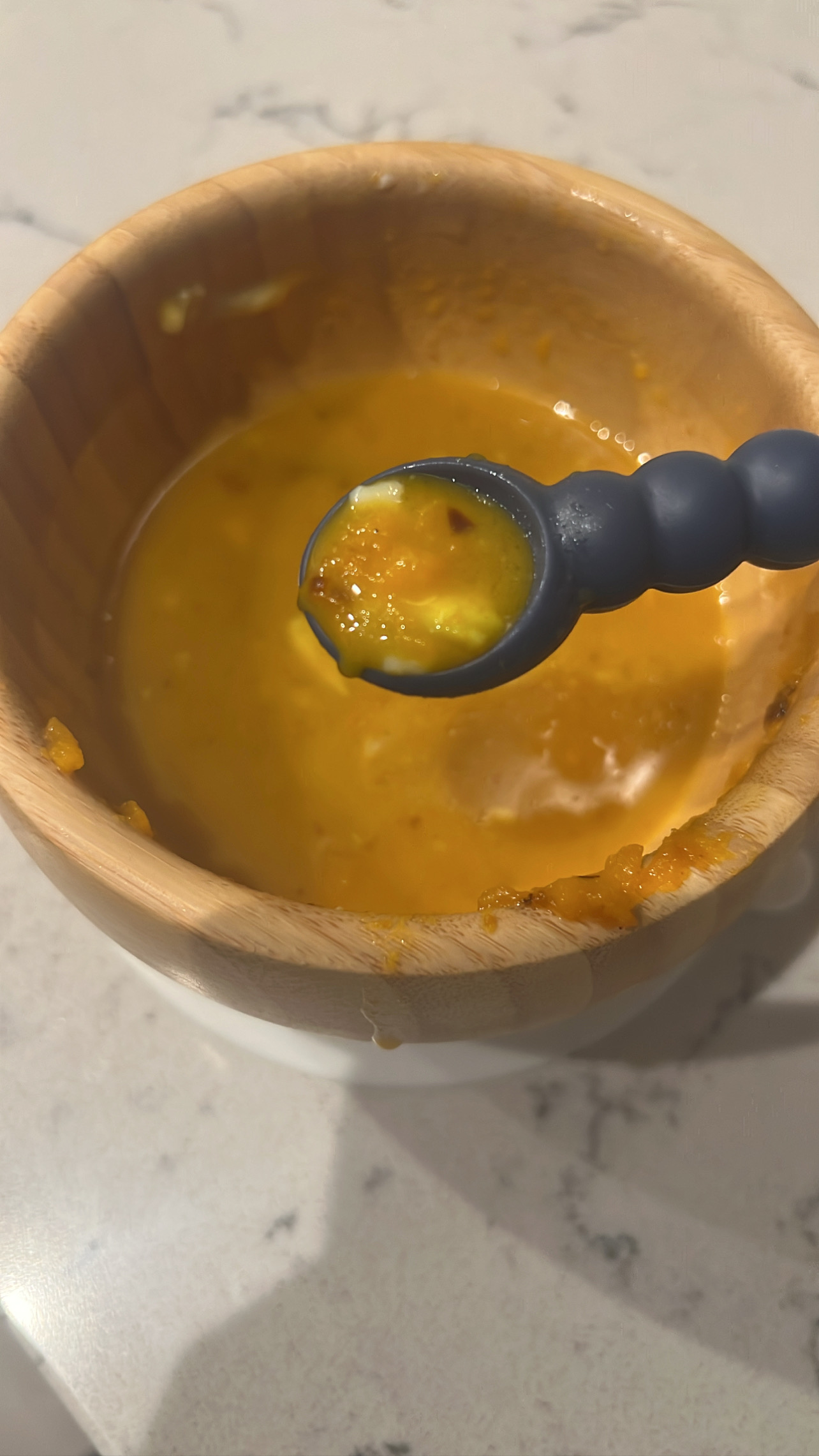
Bone broth + egg yolk + mashed squash soup
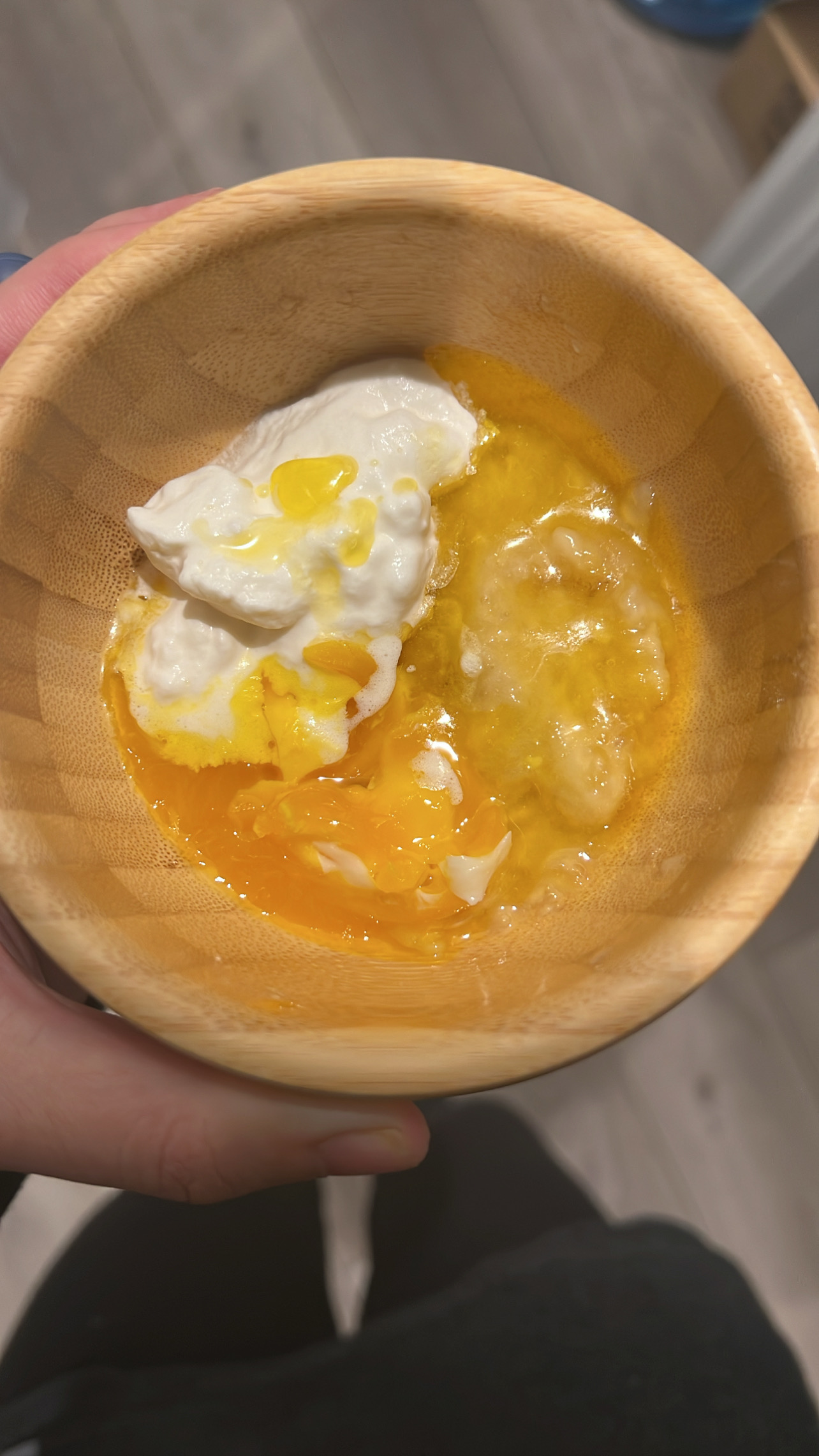
Raw cream + banana + egg yolk
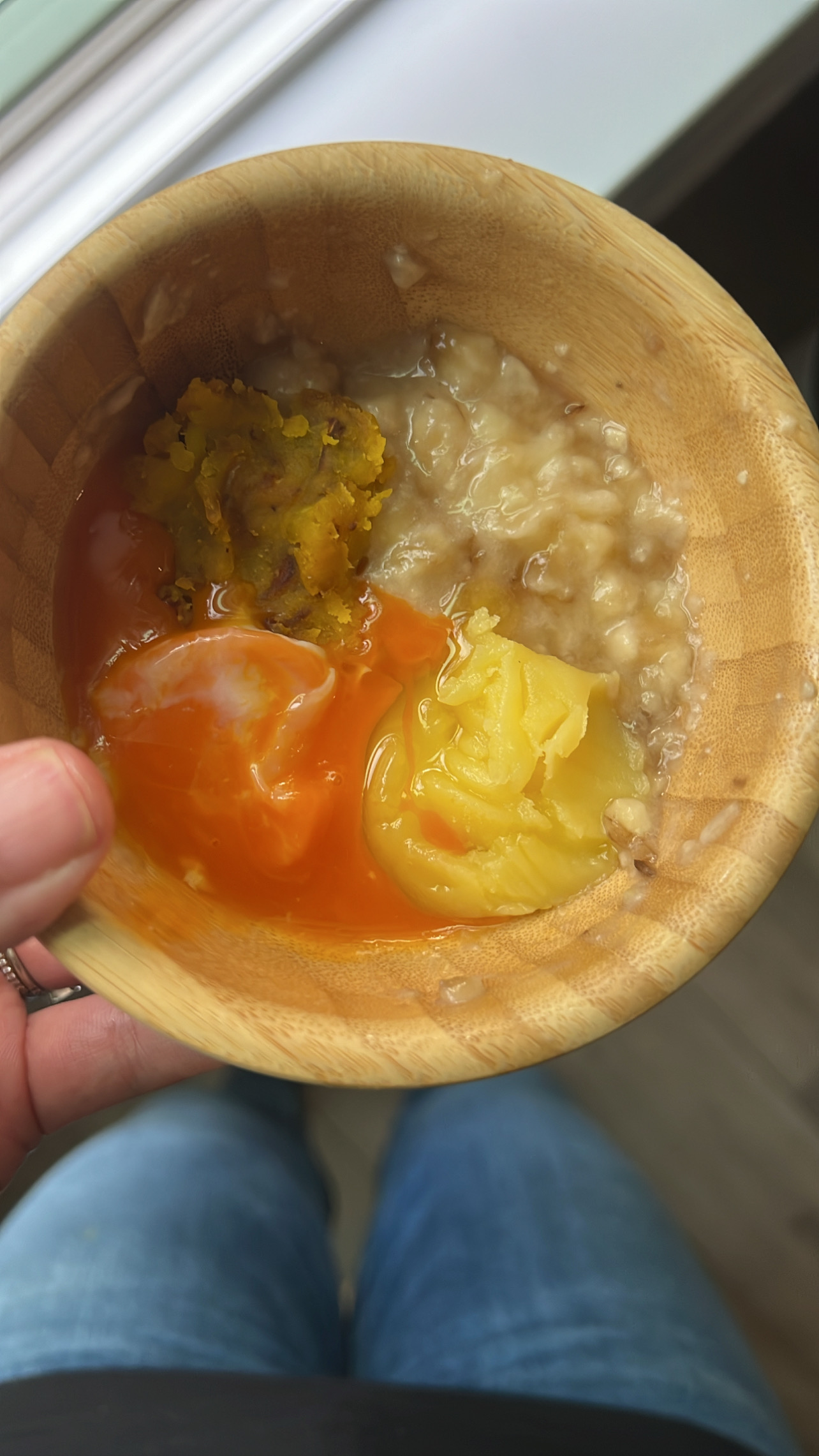
Mashed squash + banana + ghee + egg yolk
How often should your baby eat
This post from Solid Starts is helpful if you’re trying to figure out how often your baby should eat.
Note: for those who are breastfeeding, the recommendations start about halfway down the page.
I started with one meal per day in the very beginning, but shortly thereafter (maybe like a week or so), I switched over to two meals per day and stuck with that.
I will occasionally skip a meal if I feel like Farrah’s digestive system could use a break or if she’s been eating a lot of heavy foods. If I skip a meal, I do a breastfeed in its place.
Note: Farrah is 8 months old and still nurses on-demand and throughout the night.
For us, a day usually looks like this:
- Wake up + nurse
- Wake window
- Nap
- Wake up + nurse
- Meal 1 (about 45 minutes after nursing) + wake window
- Nap
- Wake up + nurse
- Wake window
- Nap
- Wake up + nurse
- Meal 2 (about 45 minutes after nursing) + wake window
- Sleep (nurse to sleep + throughout the night)
She is close to dropping a nap, so some days she takes only two naps which leaves a larger wake window midday. I sometimes add a feed (breastmilk) on these days, but other times I don’t. I go off of her lead. animal-based first foods solids
I’m obsessed with salt.
Find out why here.
Is my baby getting all of the nutrients they need from the meals I prepare?
This is a great question.
Without regularly testing your baby, there is no way to know for sure. And I’m pretty sure most parents don’t want to stick their baby for a blood test unless they absolutely have to.
But if you’re feeding your baby a nutrient-dense diet, rest assured you have a great starting point.
The primary marker of health I use for my daughter is how she looks and acts.
How is her color? Are her eyes vibrant? Is she laughing and smiling often? Does she sleep well? Is she eager to move? Does she settle easily? Does she appear content?
Something else I did was complete a comprehensive blood panel and hair mineral analysis to determine where I was at with my vitamins, minerals, and nutrients.
I figure if I’m giving myself what I need through my diet, I can assume I am giving Farrah what she needs since I feed her in a similar way.
But one difference between our diets is the real food supplements (organs, fish eggs, desiccated oysters) I take, as she can’t take those yet.
So something I do on occasion is open one capsule over her food to give her a little nutrient boost.
I also give her Cod Liver Oil (CLO) a few times per week.
Before we introduced her to citrus, I started her on this one at around 5 months old. Nordic Naturals uses low temp processing and their oil has just three ingredients: cod liver oil, rosemary, and tocopherols. The price is great too.
Since we’ve now introduced Farrah to lemon, after she is done with the Nordic Naturals bottle, I plan to switch her over to the one that we use (Jigsaw), which has only two ingredients: cod liver oil + lemon flavor (from real lemons). Jigsaw uses low temp short-path distillation and their cod is flash-frozen within an hour of being caught. (ASHLEYR for $10 off)
For the purest CLO on the market (raw and unprocessed with no flavor added), go for this one. The only downfall is the cost.
I apply this magnesium lotion (parents swear by it – read the reviews) to Farrah’s feet after her baths to ensure she is getting enough magnesium.
And as for vitamin D, I sun her regularly. CLO takes care of vitamin D too, as does breastmilk (assuming mom’s levels are over 40).
Cup and utensil practice
As for cup practice, we mainly use her straw cup now.
She also has an open cup and a little mason jar (it’s so cute). We haven’t used those as much yet.
My husband lets her drink out of his water glass whenever she reaches for it, so she has gotten some unplanned open-cup practice. It just hasn’t been structured or regular.
Sippy cups aren’t great for jaw/palate development, so we’ve stayed away from those.
As for when we do cup practice, I offer her water in her straw cup outside of her meal.
I don’t drink water with meals as I hear it can hinder digestion, so it just made sense to do the same for her.
We usually do cup practice in the evening. It’s an isolated event for now.
As she gets older and starts to move around, I plan to get her this straw cup (it’s weighted with a click-and-lock lid) that she can carry around with her and drink out of whenever she is thirsty.
Update: we switched straw cups! We use this one (insulated) and this one (non-insulated) now. They’re made of stainless steel and silicone (much better than the weighted plastic one I mentioned above that we used for a little while). I also really love the straw design. It’s unique in that you need to bite it and suck in a certain way to make the fluid come through – prevents overwhelm for babies who are learning how to use straws. I use the non-insulated one for water and make sure it’s full at all times. I leave it in her playroom so she can grab it whenever she wants. As for the insulated one, I use that to serve smoothies and raw milk. It’s also great for hot or cold drinks if we’re on the road.
Another update: A friend recently informed me that back in 2018, Pura Kiki (the bottles we use that I linked above) had an issue with their insulated bottles. It seems that if and when the bottom of an insulated bottle fell off (which happened somewhat often I think), the lead sealing dot would be exposed. Below is a picture of an exposed dot.

The dot was tested and it came back at 397,000 ppm lead. Children would play with the bottle and scratch the dot off. I think some got lead poisoning as a result. Pura apparently remedied this by sending out replacement bottles that they claimed were lead-free.
Shortly before learning about this info, strangely enough, the bottom of our insulated bottle fell off. This is what it looked like inside:

This doesn’t look like an exposed sealing dot, so I’m pretty sure there was no issue here. I did here a rumor though that Pura is still selling insulated bottles that have the exposed lead sealing dot. Not sure if that is true or not, but to avoid the drama, I decided that I’m just going to use their non-insulated bottles moving forward (which are lead-free). I tried a Hydro Flask recently thinking it would be a better option. Farrah didn’t love the straw and she made a mess everywhere. The straw design and leak-proof nature of the Pura is unmatched – at least for this age. animal-based first foods solids

As for utensil practice, we do that with her evening pureed meal.
I load the spoon and hand it to her, and she grabs it and feeds herself. She sometimes drops the spoon on her tray right after she is done with her bite, which I interpret as her wanting more. So I grab it, load it, hand it to her, and she repeats the process.
Other times she’ll hang on to the spoon for longer – playing with it, gnawing on it, or just looking at it.
And sometimes she has zero interest in feeding herself and just wants me to feed her. (This rare, but it happens.)
I try to have a mixed approach of allowing her to play and explore but also continuing to guide the meal along.
Update: we switched utensils! We use these now, and they work really well.
animal-based first foods solids

Tools we use
I document nearly all of Farrah’s meals on Instagram, along with videos and photos of her exploring food.
If you’re interested in following along, check out my “Baby Eats” highlight on Instagram.
I get a good amount of questions about the tools we use. For the most updated list of tools w use (since we’re trying new things all of the time), check out my Amazon store (Baby Eats).
Our low chair (linked below) is the only thing we use that’s not on Amazon. animal-based first foods solids
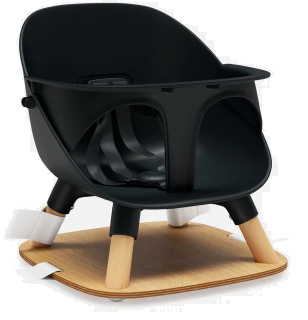
Final thoughts
I hope you found this blog post useful.
Farrah and I are nearing 1.5 months into our solids journey and it has been a lot of fun so far!
I’ll leave you with this excerpt from Nourishing Traditions:
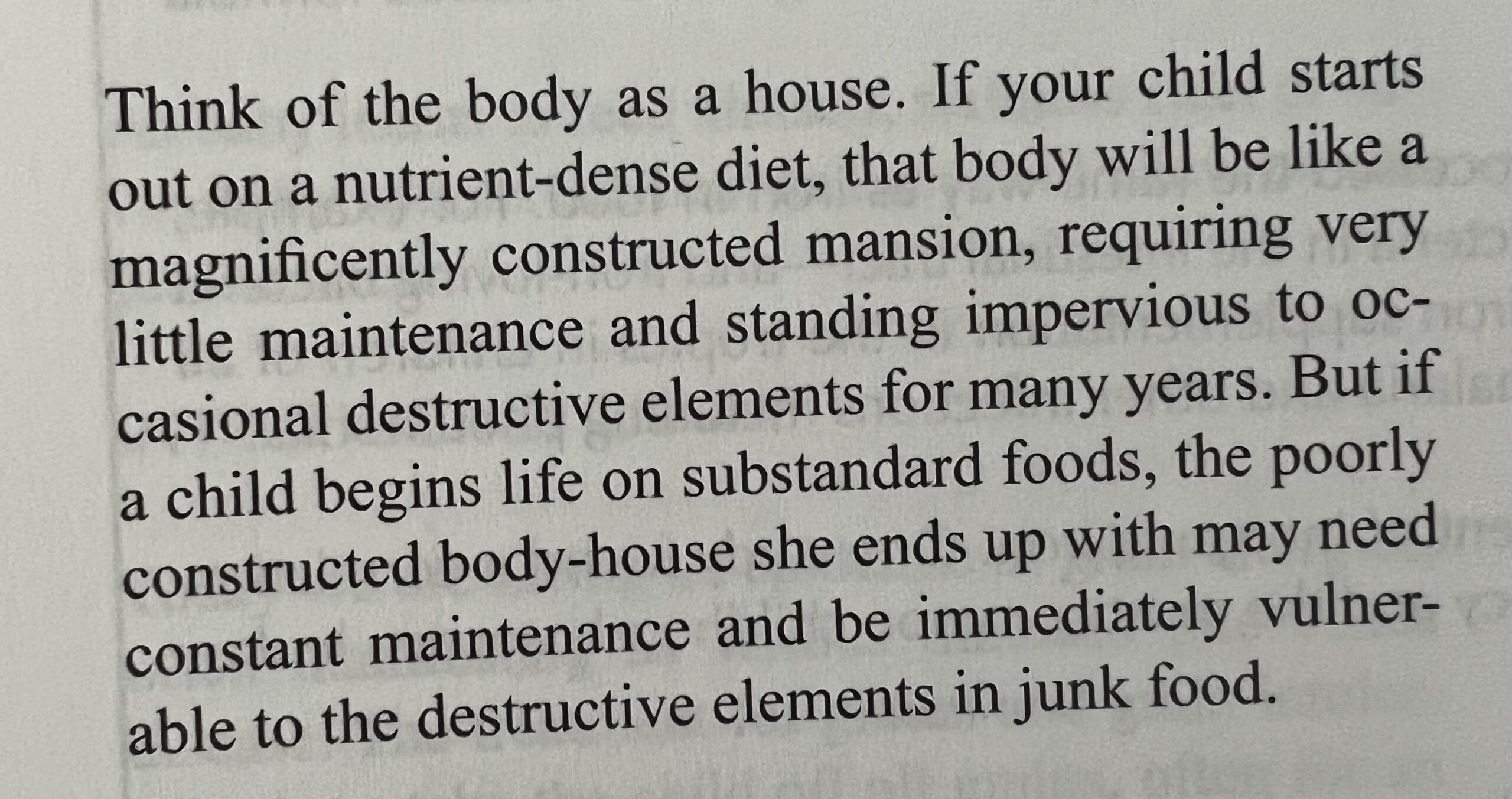
If you have any questions, do not hesitate to reach out to me at asheatsgood@gmail.com.
For more animal-based pregnancy, birth, postpartum, and motherhood resources, check out my Pregnancy hub. animal-based first foods solids

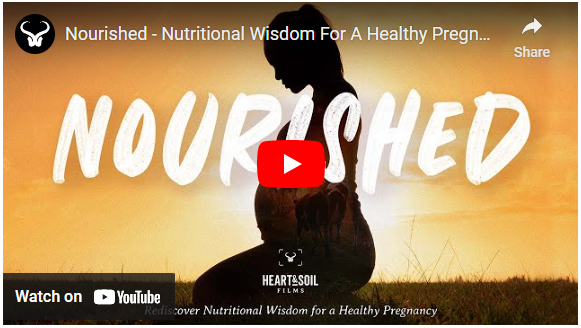


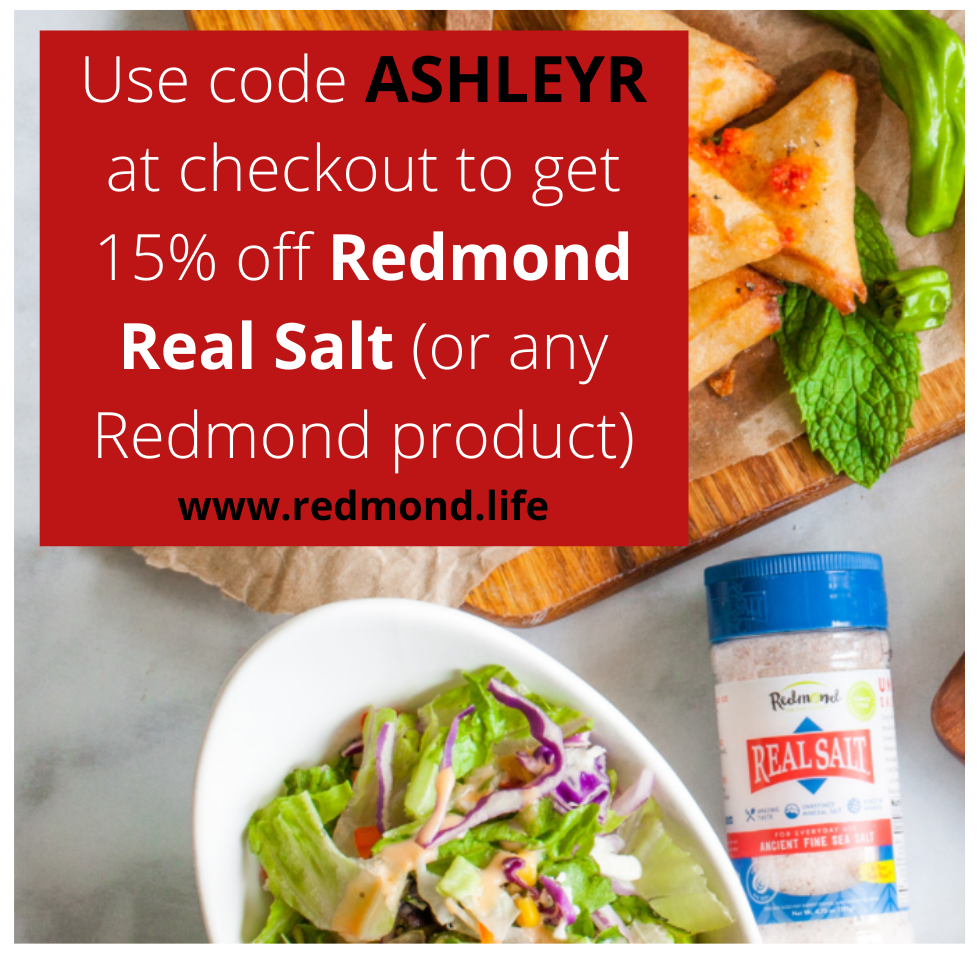
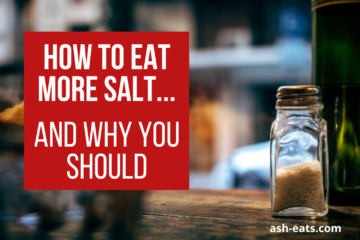

Thank you soooo much for all the photos and this article! Very helpful!! Especially the photos!
What about the old feeding the same food 3-5 days in a row to monitor reaction? Is that mainly for people feeding high toxic vegetables?
Author
You can do that if you want. My daughter has never really had any major food reactions, so I never felt the need to. But I was a bit more cautious in the very beginning for sure.
Hi,
Thank you for sharing your journey. I have a question about egg yolk. I don’t have an Instagram account, so I am not able to follow you on prepping egg yolk for my baby. But I saw the pics of them…they are raw, correct? Can I serve egg yolk cooked and mix with yogurt? or cream? or breastmilk?
Author
They are not raw. I soft-boil them (bring water to a boil, boil for about 5 minutes, then flash with cold water immediately once done boiling). You can mix them with anything you want.
Thank you so much for your helpful informatipn and experievce. My sun is 7 months old. I started to feed him at 6 moths old with spoon feeding sometime weaning. Now he does not want to be feed by spoon and he almost does not eat anything just bread feeding. So if could you give me a advice. Thank you so much!
This post is awesome! Thanks for all the pictures and descriptions of meals! Any ideas for a healthy birthday cake for my soon-to-be 1 year old??
Author
Many folks have turned my spongey cake bars or plantain flour muffins into cakes with success!
Cake bars: https://ash-eats.com/spongey-cake-bars/
Plantain flour muffins: https://ash-eats.com/cupcakes-with-raw-buttercream-frosting/
Thanks for the super informative blog post and all the example meals for ideas. We’re going to start our solids journey today – first up egg yolks!